Nearly $6 million in gifts came from Northampton School for Girls alumnae
Gifts ranged from 2,400 first-time donations to the biggest gift in school history!

Nearly $6 million in gifts came from Northampton School for Girls alumnae
Gifts ranged from 2,400 first-time donations to the biggest gift in school history!
Thanks to all of you, Williston blew past its original goal and raised $86 million
What’s new? For starters, the Residential Quad, souped-up science labs, increased financial aid funding, and more
One thing that hasn’t changed: Williston’s unique DNA
Director of Communications
ANN HALLOCK P’20, ’22
Design Director
ARUNA GOLDSTEIN
Assistant Director of Communications
DENNIS CROMMETT
Manager of Story and Content Development
GEOFF SMITH ’07
Head of School
ROBERT W. HILL III P’15, ’19
Chief Advancement Officer
ERIC YATES P’17, ’21
Director of Alumni Engagement
DELENEY MAGOFFIN
The Williston Northampton School Advancement Office 19 Payson Avenue Easthampton, MA 01027 email: info@williston.com online: williston.com bulletin online: williston. com/bulletin
Nondiscrimination Statement: Williston admits qualified students of any race, color, national or ethnic origin, ancestry, gender, religion, gender identity, gender expression, sexual orientation, or mental or physical disability, and extends to them all the rights, privileges, programs, and activities generally accorded or made available to students at the school. The school does not discriminate on the basis of race, color, national or ethnic origin, ancestry, gender, religion, gender identity, gender expression, sexual orientation, or mental or physical disability, or any other status protected by applicable law in the administration of its admissions, scholarships, and loans, and its educational, athletic, and other policies and programs.

8
In preparation for the Fall play, Sofia Oblomkova ’29 develops outfits in the costume shop. See other candids of campus life in our Snapshots section.
Jade Morris takes the baton as Williston’s first-ever female Athletic Director
For six Williston students, a journey to Alaska was more than just a summer vacation
10
At Convocation, senior class
President Isabel Baxter-Paris ’25 explored the 100th anniversary of Northampton School for Girls and the legacy of women’s education


42
Zoë (Neal) François ’85 serves up spectacular cookie recipes that are rich with practical tips and deep personal history FIND
In his recent show, Ed Hing ’77 uses AI to bring his father’s past to life
Thanks to 5,677 donors, the Williston Builds campaign has made a tangible difference in the lives of students today
Ed Hing ’77 brings his father’s past to
From fan to the front office, Brittany Glenn ’07 is seeing Celtics success up close
We’re still smiling from the spectacular achievements of Gabby Thomas ’15 at the Paris Olympics
Brendan McCartney ’08 is helping accelerate the shift to clean energy
Betsy Assoumou ’05 finds a new calling—and connects with fellow alum Cherie Holmes ’75—as a medical resident in
Zoë (Neal) François ’85 serves up recipes that are rich with practical tips and deep personal history
For Kaden Green ’23 and Caleb Boyko ’23, the idea for their highflying start-up dates back to an unusual spot: the Williston library
Follow Williston Northampton online for more ways to connect with your Wildcat pride.
linkedin.com/school/ williston-northamptonschool
facebook.com/ willistonnorthampton
instagram @willistonns
flickr.com/ willistonnorthampton
youtube.com/@ willistonnorthampton
The success of the Williston Builds campaign has had a generational impact on our campus, our community, and our future as a school
If Samuel and Emily Williston were to be transported from 19th century Easthampton to the present-day school that proudly bears their name, I can only imagine how their New England sensibilities would be upended. Imagine their amazement upon seeing the campus today, or in learning that the Williston Builds campaign raised more than $86 million, a number far eclipsing any other such effort in the school’s 184-year history. Imagine Emily Williston walking into Emily McFadon Vincent House —the iconic dormitory anchoring the equally transformational Residential Quad—which highlights the role of women and the Northampton School for Girls in the school’s rich history. Imagine them both attending graduation—two people committed to educational access—and seeing students from 25 states and more than 25 different countries being recognized for their talent as they embark to the most selective undergraduate programs across the country. I can only imagine the pride they would feel upon seeing the results of the seeds they planted so long ago.
When I came to Williston in the summer of 2010, it did not take long for me to perceive a peculiar institutional character trait. Namely, the school had so much talent, both obvious and latent, and yet nobody ever “bragged” about Williston. For all of you who are reading this Bulletin (which, notably, has won the most distinguished award granted to such publications among schools and colleges), it’s high time to brag about Williston. There’s

Despite his own education being cut short due to poor eyesight, Samuel Williston became a sucessful industrialist and was deeply committed to education— founding Williston Seminary in 1841.


“EMV,” as it’s known on campus, honors a 1949 graduate of NSFG, and is the first dorm named for an alumna. Home to 40 female students, it celebrates its girlpower lineage with a handpainted Rosie the Riveter banner in the common room.

In 2023, the Bulletin won the Robert Sibley Magazine of the Year award. Judges praised the “energy and style that immediately catches the reader’s eye right from the cover!”

nothing wrong with acknowledging exceptionalism when it’s authentic, and yet in a world dominated by the hyperbolic assertions of click-bait social media posts, it can sometimes be hard for people to tell the difference between the two. In this issue’s special campaign section, starting on page 11, what you will read is an authentic account of the generational impact occasioned by the completion of the Williston Builds campaign. These past eight years have seen Williston become stronger by every measure, from admissions and college outcomes to endowment and faculty recruitment.
for teachers, to new tennis courts, there’s something for everyone to celebrate in the campaign’s success. None of this happens without vision, collective effort, and philanthropic support.


For two decades our popular ninth grade program has built companionship and community through orientation overnights, shared housing, and gradespecific issue-focused social events and programs.
One cannot step onto Williston’s campus without seeing the campaign’s impact. The new Residential Quad, accommodating more than half of the boarding student population, has consolidated and shifted the campus’s residential center. Students no longer cross a much busier main street to what some recall as the “Main Street Campus,” and the school has privatized Brewster Avenue, once a busy cut-through for town traffic—the elimination of those crossings are significant safety enhancements. Moreover, given that all ninth grade boarding students now reside in the new dormitories—with their inviting common rooms and wonderful porch spaces—form meets function, and programming specific to the ninth grade occurs as part of the school’s community life focus. While the new quad buzzes with students having fun playing Spikeball or relaxing around fire pits, what lies underneath is as important. Three dozen geothermal wells help heat and cool the four dormitories on that part of campus, highlighting our commitment to energy efficiency and the environment.
So, I urge everyone to explore all that’s changed due to the success of the campaign, and to particularly see how the school today compares to your time at Williston. From completely renovated science classrooms and preparation spaces
When asked what I consider to be of the greatest impact, I often point to the tremendous importance of the campaign to student and faculty lives. Not only have faculty families benefited from the beautiful homes attached to Emily McFadon Vincent and John Hazen White dormitories, but the infusion of $5.5 million to our endowment earmarked for faculty support has bolstered salaries and professional development opportunities. Similarly, endowed support for students—both for financial aid and for funding groups to attend national peer-to-peer programs—has expanded and enriched the entire community. None of this would have been possible without the incredible contributions of time and money by so many alumni, parents, and friends during the campaign.
I marvel at the Williston of today, and we’ve made a great leap toward securing our future as a school of choice for students from around the world. Our graduates achieve distinction as scholars, athletes, and artists at the finest colleges and universities, and our faculty are recognized in publications and presentations at the national level. With the overwhelming support of alumni, trustees, and parents past and present, the Williston Builds campaign inspires us to look forward to next steps, ones that will focus on improving our academic spaces and bolstering endowment funds. We have never been more grateful for the accomplishments of our past nor optimistic about all that is to come—Williston has never been stronger.

This state-of-the-art dormitory on the Residential Quad—officially named on October 30, 2018— honors John Hazen White Jr. ’76, Chair of the Board of Trustees and tireless advocate for the school.

The Williston Builds campaign boosted the school’s endowment from $36.6 million to $60.2 million, an increase that provides new flexibility for targeting financial needs. Read more about the endowment and its impact on page 38.

Where are Williston students matriculating? See williston.com/ college-advising

1.
REUNION 2025
The countdown is on! Whether it will be your 50th or your 5th, come back to campus next June to celebrate, big time. A special NSFG gathering will also commemmorate the school’s 100th. Find out the details at williston.com/reunion
5.
QUEENS OF THE POOL
The Williston girls water polo team continues to set records. This past spring, the Wildcats secured their third straight NEPSAC championship, and did it while going undefeated on the season. The team is on a 39-game winning streak dating back to the 2023 season. Go, Wildcats!

2.
GO BEHIND THE SCENES
Want to see what life on campus is like today? Head to our YouTube channel to check out a new series of videos that take you behind the scenes in the dorms, dining hall, and more.




3.
Just before study hall one night this fall, the aurora borealis, aka the Northern Lights, turned the sky over campus bright pink, inspiring oohs, ahs, and more than 1,000 likes on our Instgram post. See more at @willistonns
4.
The Willistonian earned second place in American Scholastic Association’s annual newspaper awards, which honor top student publications.



Seniors Gabi Bobiak ’25 (right) and Pearl Rungrotkitiyot ’25 came to Williston from opposite ends of the planet: New Hampshire and Thailand. Now roommates in Emily McFadon Vincent House, they have a closeness that only dorm life can bring. “She knows more than any one of my friends— I tell her everything,” says Bobiak. “Having that level of support when you get to your room is so nice—like, perfect.”

Jade Morris takes over as the school’s first female Athletic Director BY GEOFF SMITH ’07
The newest Director of Athletics at Williston is set to make some history as she settles into her role. Jade Morris, hired this summer following the retirement of Mark Conroy, is the first female lead in Williston athletics history, and joins a distinguished short list of Athletic Directors. Conroy retired after 24 years as A.D., and he replaced Rick Francis—himself the
school’s Athletic Director for 32 years. Morris is comfortable—and excited— to be stepping into the large cleats she has been asked to fill.
“I’m coming into this strong foundation of an athletic department with a solid culture of teamwork and work ethic and just getting the job done,” she says.
Raised in the Pioneer Valley, just a short drive away in Westhampton, Massachusetts, Morris gradu-
It’s an honor and privilege to be the first female Athletic Director, and I believe in that mantra ‘If you can see her, you can be her.’”
ated from Hampshire Regional High School, then enrolled as a dual-sport athlete at the Massachusetts College of Liberal Arts in North Adams. The A.D. at Hampshire when Morris attended was a woman, and it planted a small seed in her head—albeit not one ready to be watered. At MCLA, Scott Nichols, the school’s A.D., dumped the watering can on Morris.
“I was all set to be a kindergarten teacher,” explains Morris with a laugh. “And my senior year, [Nichols] asked me, ‘Have you thought about working in college athletics?’ I said, ‘No, what does that even mean?’”
Nichols explained what that kind of work entailed—managing the department, working with coaches, helping set schedules, developing leadership in students—and Morris was intrigued. With the idea starting to sprout, Morris spent time volunteering at Wellesley College, a Division III women’s school. Exposed to the administrative side of athletics, Morris was hooked and decided to pursue the work as a full-time career. She returned to school at Springfield College for two years that would prove life-changing.
At Springfield, Morris met her husband, Mike, and studied under the guidance of now-Director of Athletics Craig Poisson. Morris says it is difficult to articulate just how much of an influence Poisson had.
With her master’s degree in hand, Morris scored a job at Boston College,
first as an Assistant Director for Stewardship and Donor Relations, then Senior Associate Director for StudentAthlete Development. In August 2022, she made the jump to the prep school ranks, working for Belmont Day School as its Associate Athletic Director. When she saw the Director of Athletics position open at Williston, Morris wasted no time applying.
“When I applied, I felt like an out-of-the-box candidate,” Morris acknowledges. “But the more I researched, the more I realized this is for me. The timing felt right.”
Morris has hit the ground running since she started, and she and her family—husband, Mike, and kids, Ryan, Matt, and Tess—are settling in well.
“People here love this community,” she says. “I’ve had such a warm welcome from [Head of School Robert W. Hill III] and supportive leadership. Everybody is asking what they can do to support me. It’s awesome.”
Morris says her initial goals are to get an overall sense of the program and how it’s run, connect with Williston staff and students to start fostering connections, and continue evolving Williston athletics in the digital age and supporting student-athletes wherever they need it.
“It’s an honor and privilege to be the first female Athletic Director, and I believe in that mantra ‘If you can see her, you can be her,’” Morris says. “Being a role model for young females is important to me.”
Six students put their science skills to work documenting the ecology of a remote Alaskan wilderness
BY GEOFF SMITH ’07
Science classes make up a large part of the core curriculum for a Williston Northampton student—replete with labs, written coursework, and plenty of observation. But for six Williston students, this past summer was about putting all of the theory they learned in a classroom into action in the real world of Alaska.
As part of a trip led by science faculty member Bill Berghoff, students Joey O’Donald ’25, Jack Berrien ’25, Maya Zesiger ’25, Alyssa Matricciani ’25, Maddy McCarthy ’25, and Ava Medaugh ’25 headed across the country to live for two weeks on a boat off of Montague Island in Prince William Sound. During their stay, the students did research for a benchmark study— a report that provides an ecological snapshot of the local environment, to be used by researchers and scientists studying the area in the future. Each student was given a specific task during the stay.
Jobs included tracking mammals and marine life; observing foliage and plants; recording mineral reserves; and simply tracking the weather. Because of their location, the group even got to name a small island they found—Blustery Point. Combined,

the reports were assembled during Fall 2024 to complete the study, which will be submitted to the National Forest Service.
“It’s amazing to be the first people to study this area,” said Berrien, “because we think about how the world is pretty much mapped. It’s incredible and eye-opening that this benchmark study could be the first of many to better understand the world of climate change.”
While the experience of observing
the Alaskan wilderness is adventure enough, living on a boat for the duration of the stay added an interesting wrinkle. The six students stayed in one room of bunkbeds, and were put on rotating chore schedules—including cooking meals and cleaning up the cabin.
“It made [the trip] so much more real,” said McCarthy. “Being so incredibly immersed in the nature and beauty around us constantly—it was surreal.”

Part of the group’s trip included a visit to a salmon farm, a spot also popular with local bears

In order to properly observe their surroundings, students had to be willing to jump right in—sometimes quite literally

The group stayed on board the Endeavour, a 72-foot-long vessel built in 1954 for the U.S. Army
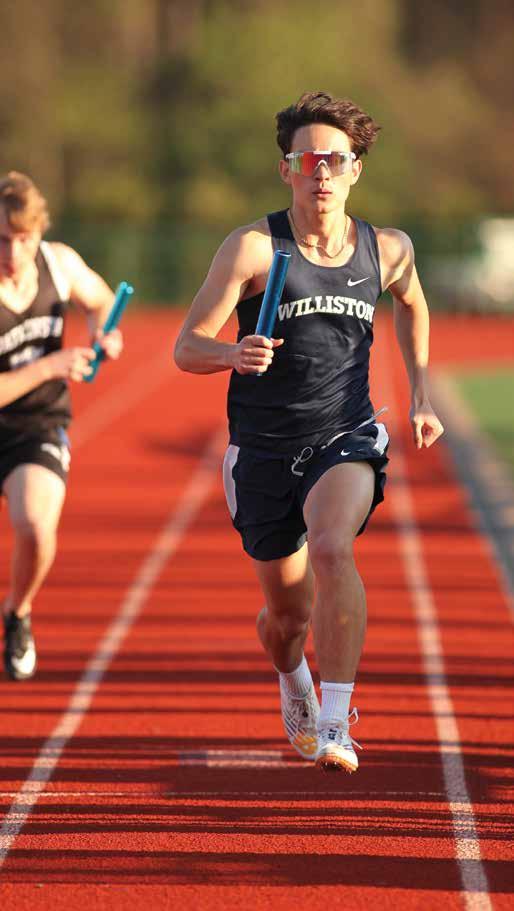

A Convocation highlight was the keynote by Christina Djossa ’10, award-winning writer and audio producer for The New York Times. Read her speech at williston.com
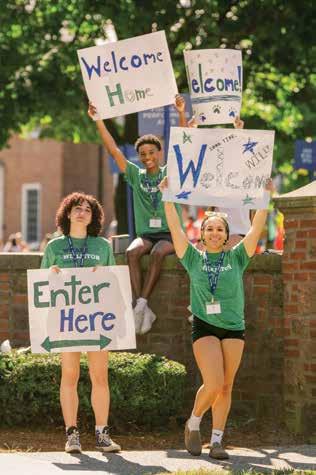
Williston’s boys track and field team—including relay member Sokichi Sullivan ’25, shown here—continued its impressive run of success, with the 2024 team finishing 17-1, the ninth straight winning season. Over the last two seasons, the progam has amassed an impressive 32-1 record.
The Williston community welcomes new students from the moment they arrive on the Main Quad, literally with open arms. Welcome Days help set the tone for a successful year— and this year’s festivities were marked by warmth and joy.
Students at a “white-out” game cheer on the varsity football team, which has been on a tear this fall. As of press time, the team was 7-1 for the season, and headed for a bowl game. Go, ’Cats!
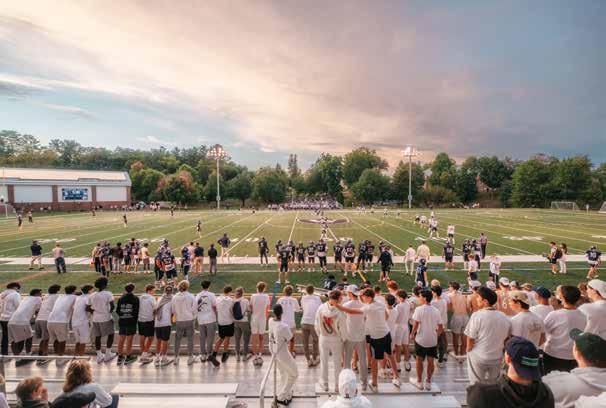

The end of each academic year is celebrated with our Willy Gras celebration, and the 2023-24 theme was a riff on Nintendo’s popular Mario franchise. One new event: a Wildcat version of Mario Kart. Students competed in a tricycle relay race around the Main Quad loop, completing objectives along the way. There were no banana peels to foil racers—but wipeouts still brought cheers and laughter.
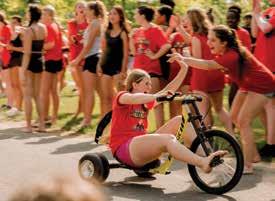

At the school’s 184th Convocation ceremony, senior class President Isabel Baxter-Paris ’25 explored the legacy of women’s education. Her remarks are excerpted below.
This year, we commemorate a momentous milestone in our school’s history, the 100th anniversary of the founding of Northampton School for Girls. As many of you already know, Williston Academy was an all-boys school until 1971, when we merged with Northampton School for Girls to become the Williston Northampton School.
Of course, we are now a thriving coeducational institution, but I believe that all students, regardless of gender, can learn valuable lessons from our predecessors at Northampton School for Girls.
A century ago, Sarah Whitaker and Dorothy Bement established Northampton School for Girls, which dared to prepare young women for higher education (and even the workforce). Many women’s schools during this period primarily functioned as “finishing schools,” but Miss Whitaker and Miss Bement were determined to provide their students with an education that rivaled—dare I say, exceeded —that of all-boys schools like Williston Academy.
Revolutionary during their time— when women’s education was mainly focused on typing and home economics, not intellectual rigor—the students at Northampton School for Girls rose to meet every challenge: for example, seniors completed summer reading assignments that often exceeded 30 books. So, those of you in the audience who haven’t started your summer work would have been in serious trouble.

“I believe that all students, regardless of gender, can learn valuable lessons from our predecessors at Northampton School for Girls.”
planted me on a street corner when I was 5 years old and told me to hold a campaign sign for a U.S. Senate candidate; she wanted me to understand that anyone, at any age, had the power to have their voice heard and impact their community.
As I think about the legacy of women’s education in this country, it is remarkable to recognize how far we have come. It is possible that in this momentous year, a century after the founding of Northampton School for Girls, a woman could finally shatter the highest, hardest glass ceiling, and potentially assume the presidency of the United States.
I can think of no one who has lived up to these two ideals more than our inspiring alumna Gabby Thomas ’15. Obviously, Gabby is an exceptional athlete; she now holds five Olympic medals to prove it. But although she might be known around the world for her athletic prowess, she is revered in her local community for volunteering at a free clinic.
During the Great Depression, Sarah Whitaker worked without pay, waiving tuition fees for countless families, to ensure that cost was not a barrier to receiving an outstanding education. During World War II, worker shortages on local farms created a need for additional potato farmers. Northampton School girls answered the call, and woke up at dawn each morning to harvest potatoes and asparagus before arriving at English class. After the war, the school raised funds for a French town that had been decimated by the German occupation, and Miss Bement was even awarded a medal
from the French government for her efforts.
Not only did Miss Whitaker and Miss Bement offer generations of students access to a higher-quality education, they encouraged them to take action beyond their school community, and go on to impact the world in ways their mothers and grandmothers never could have imagined.
I know a little something about strong women. My great-grandmother was a nurse at a local women’s college who, in the 1960s, stopped at nothing to ensure her patients had access to reproductive health care. My mother
Although she was not awarded a gold medal for these contributions, Gabby’s impact can be measured by the life-changing kindness and assistance that she has shown.
This school year, I challenge all of you to channel the spirit of Sarah Whitaker and Dorothy Bement: Balance the pursuit of excellence with kindness and engagement in our school community. What will our impact be on one another? On the world that lies ahead of us?
Watch Isabel’s speech and see the full transcript at williston.com
Williston Builds was the most ambitious fundraising initiative in Williston Northampton's 183-year history.
Our goals were simple. To elevate the school in four key areas: Community, Access and Belonging, Academic Excellence, and Momentum. Eight years, 5,677 donors, and $86 million later, we've been able to build far more than we ever dreamed. Turn the page to find out more.

If you could point to one key to this campaign’s success, what would it be?
Definitely people— Williston Builds was the ultimate team effort, with nearly 6,000 alumni, parents, grandparents, employees, and others contributing over the past eight years. The $86 million total reflects a huge range of gifts and donors. We had donors who made their first gifts ever, and donors who continued a 65-year giving streak. We had the largest gift in school history (see page 31) and small Venmo donations from current seniors on Founders Day. All of these were absolutely essential in helping us reach our goal. Beyond the dollars and cents, many people also gave their time— as alumni volunteers, event attendees, social media boosters, and members of our Board of Trustees or new Head’s Visiting Council, our alumni ambassador group that has been invaluable in guiding communications and fundraising. Looking at any measurement, from attendance at Reunion and events to participation in Founders Day, engagement is definitely at an all-time high.
What was the most memorable or unexpected part of the campaign?
Completing the new Residential Quad was an enormous accomplishment. Seeing that space quickly become a central part of campus life has been deeply gratifying, because it marks the culmination of years of conversations, planning, and a leap of faith from some major donors. It’s really almost impossible to
Chief Advancement Officer Eric Yates reflects on what made the Williston Builds campaign so successful—and what comes next

imagine our campus without it now. In terms of curveballs, in March 2020, just as we were about to launch the public phase of the Williston Builds campaign, COVID hit, and we had to shift our focus virtually overnight. It was an all-hands-on-deck effort to keep the school operating and provide continuity for students, so everything related to the campaign was put on hold indefinitely. But not surprisingly, the Williston community stepped up, both during COVID and after the campaign relaunch, and we quickly got back on track again.
paign has us thinking bigger. We’re capable of achieving big things through philanthropic support, and we’ve proven ourselves worthy of that investment. This is the path forward—through philanthropy, Williston is evolving into a stronger, even more capable version of itself.
What’s next for Williston after the success of this campaign?
I’m proud of all we accomplished through Williston Builds. As you’ll see on the following pages, sustaining a multiyear comprehensive campaign has been
“This campaign was about more than just reaching a number; it was about celebrating what’s best about this community and laying the foundation for Williston’s next great chapter.”
Do you think the campaign has changed the way alumni and others feel about the school?
This campaign was about more than just reaching a number; it was about celebrating what’s best about this community and laying the foundation for Williston’s next great chapter. Williston has always had a bit of a “we-try-harder” attitude, bringing a scrappy mentality to developing our people and programs. Perhaps this stems from years of doing more with less—balancing limited resources of time, funding, and people. It may also reflect a culture that values authenticity and hard work. We’re still that school. That hasn’t changed. But the success of this cam-
vital for the shool. But from my perspective, this is the time to double down on Williston in every way. In the campaign’s final months, thanks to the generosity of supporters, we achieved so much. We endowed a new financial aid initiative and a fund to support student advisories. We attracted seed funding to launch a new faculty fellowship pilot program, and we set a new $2.75 million record for our 2023-24 Williston Northampton Fund. Now is the time to build on that momentum. Williston needs to keep growing its endowment, invest in new academic spaces, and sustain alumni and parent annual giving. We’ve proven what’s possible— and this is only the beginning.
williston builds the campaign for our community
We don’t mean to boast—well, maybe a little—but thanks to you, the Williston Builds campaign broke all kinds of records. Here are just a few of the highlights.
$9.6M
Total dollars given in support of financial aid during the Williston Builds campaign
$86M
Total dollars raised during the Williston Builds campaign

64%
Increase of Williston’s endowment during the Williston Builds campaign, taking it from $36.6 million in 2016 to $60.2 million in 2024
58%
Growth of the Williston Northampton Fund during the campaign
$26M
Amount of confirmed bequests and planned gifts that will come to Williston in the future
12
Seven-figure gifts given during the campaign (out of 18 seven-figure gifts during Williston’s entire history!)
97
Endowed funds that were added to or newly created during the campaign
5,677
Total alumni, parents, grandparents, and friends of the school who donated during the campaign

williston builds the campaign for our community

Williston has always had a community like no other. This campaign has made it even stronger.
Smiles and friendly hellos on the Quad. The way team captains make younger students feel welcome. Supportive conversations (and home-baked cookies!) in advisories. These classic Williston experiences are hard to put a price tag on, but without a doubt, they have been enhanced by campaign contributions. Additional outdoor gathering spaces, a refreshed dining commons, endowed community programs, and our new Residential Quad have all resulted in new and special ways for our community to come together.
Girls soccer coach and Assistant Director of Financial Aid
Sara Reid (second from left) lives in John Wright with her husband and their three children. “Living on campus, we get to know students in so many ways—and what’s special is they get to know us, too, as real people with kids, pets, and spouses, beyond just our roles. It’s a wonderfully close-knit community.”
williston builds the campaign for our community
If it’s been a while since your last visit, you’ll notice that the Williston Builds campaign has transformed nearly every part of campus. We’ve upgraded the quality of student and faculty housing, created community gathering areas, and enhanced our academic, athletic, and arts facilities. Below you’ll find a few notable examples (but really, come back and see for yourself!).

Two new state-ofthe-art dormitories flank the spacious Residential Quad, and replace old student housing on Main Street.
We added 80,875 square feet of new campus green space, ideal for games of Spikeball or Frisbee.
Eight new faculty townhouses, connected to two new dorms, greatly enhance on-campus housing for faculty and their families while allowing convenient access to students for dorm supervision.
We’ve made energy-efficient improvements across campus, including 61 geothermal wells on the Residential Quad, 150 new windows, 1,044 solar panels installed on the athletic center and rink, and a new heating system in the chapel (farewell, sweltering assemblies!)
The ground level of the Clapp Library was renovated in 2018 to include a new robotics lab and the Center for Academic Success, which offers tailored academic support for every kind of learner.

The Sabina Cain Family Athletic Center has been updated with a new lobby, expanded weight room, new locker rooms, a resurfaced turf field, and a new parquet observation deck that’s perfect for gatherings and game-watching.
Scott Hall’s outdated science labs were transformed into modern, flexible academic spaces, featuring updated common prep areas, new lab tables and storage, and upgraded technology.
Williston’s main stage lighting in its theater was upgraded to a state-of-the-art energyefficient LED system, enhancing performances and reducing costs.
Birch Dining Commons was refurbished with new flooring and furniture, expanding the overall capacity for community and alumni gatherings.
In the new Maker Space on Reed’s second floor, students can use lasercutters, 3D printers, and other technology to make almost any object they can dream up.
The new outdoor tennis complex at Galbraith includes 12 new courts and two viewing gazebos for spectators and teams.
williston builds the campaign for our community

Completing the new $20 million Residential Quad was one of the biggest and most visible achievements of the Williston Builds campaign. Now home to more than half of our boarding students, it’s strengthening the community experience for everyone.
Depending on when you graduated, you might remember the area behind Phillips Stevens Chapel as tennis courts, a parking lot, a community garden, or a sandlot baseball field. For future generations of students, this area is now Williston’s Residential Quad—featuring an 80,875-square-foot green space, two new dormitories housing 80 students, and eight new faculty homes. Together, the quad serves as a new central courtyard of the school, offering ninth and tenth graders a warm introduction to Williston boarding school life.

“The Residential Quad has been a game-changer for Williston,” says Head of School Robert W. Hill III. “It helps us attract new students and teachers while making our whole community feel more connected.” The quad’s open layout brings students and faculty together, enhancing campus safety and providing a space for residential life programming such as movie nights, glow-in-the-dark badminton, and campus cookouts. The dorms feature spacious
common rooms and wide front porches, perfect for gatherings.
“This is my 31st year at Williston, and you can really feel how the quad brings this area of campus to life,” says Matt Sawyer, teacher and dorm head in John Hazen White House. “Students playing Spikeball, faculty kids riding bikes, teachers walking dogs —it’s become a place where the community naturally comes together.”

Named for Emily McFadon Vincent NSFG ’49, this building is the first on campus to honor an alumna. Opened in 2021, EMV houses 40 female students and has a strong “girl power” vibe. Dorm head Christa Talbot Syfu ’98 notes, “It’s a great, close-knit place for girls to live.”

Named for current Board Chair John Hazen White Jr. ’76, this state-of-the-art dorm houses 40 ninth grade boys each year. “It feels like a real community here,” said Benning Johnson ’22.

The first of the new dorms finished, but the last to be named, Wold House was called 194 Main Street—until the school honored Peter Wold ’67 and his family in 2021 for their many contributions. Housing 32 girls, Wold House is a cozy home for students in their first year of boarding.
williston builds the campaign for our community
Check out some of the new spots on campus that encourage Wildcats to gather, celebrate, and form strong bonds
Iconic architect Frank Lloyd Wright famously said, “We create our buildings, and then they create us.” Nowhere is this more true than at boarding schools. You don’t just spend a little time in campus buildings and spaces; they are where you live, study, and play with a community from around the world. Thanks to generous donations from our campaign, we’ve been able to create new spaces on campus that encourage connection and strengthen our community. Here are some of the guiding principles we considered along the way.
Thanks to a group of parent donors, Birch Dining Commons got a major facelift in 2022, including new windows, refreshed paint and flooring, and elegant Shaker chairs. The most impactful change, though? Round tables, which create a more intimate and “family-style” dining experience, where everyone has equal access to the conversation. They also maximize floor space, expanding Birch’s capacity for large gatherings and residential dinners.
2.
Williston’s new Residential Quad, with its grand front porches and expansive lawn, has set the bar high for outdoor gatherings. On any given day, you’ll find ninth and tenth graders outside playing games, chilling around firepits, and reading in Adirondack chairs.
To bring that same feeling to the Main

Quad, we added three new outdoor areas—a patio in front of Memorial Hall (from the class of 1970), a terrace in front of Ford (from the class of 1968), and a brick gathering space outside of the entrance to Birch Dining Hall. The Ford and Mem patios, stocked with Adirondack chairs and firepits, are in constant use during the school year, as well as at Reunion. The Birch Terrace has become a go-to spot for events, with a gorgeous view of the pond. The Sabina Cain Family Athletic Center also got its own “front porch” with a new parquet observation deck above Saywer Field—ideal for watching games on crisp fall afternoons.
The bottom floor of the Reed Campus Center (if you graduated before 1996, you might remember it as the old gym’s pool) has long been a favorite student hangout. Thanks to a generous gift from



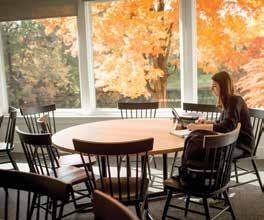
Natan Peisach ’57, this 4,000-squarefoot student activity center will be renovated in summer 2025. To ensure it continues to meet student needs, feedback from the student council is being incorporated into the renovation plans. The goal is to enhance student activities, foster connections, and keep it as the go-to spot for grabbing an ECB sandwich or playing ping-pong.
Community building was a top priority in the design of all three new Residential Quad common rooms. With high ceilings and 700 square feet of versatile space, these areas feel like large family rooms—where students can study, eat, relax, make new friends, or attend dorm and club meetings. A prime example is the Cadwgan Family Common Room in the new ninth grade boys’ dorm, named in honor of Ruth and Gordon Cadwgan ’63, who made the first million-dollar gift to the Williston Builds campaign. This common room is the largest and most prominent interior space in the new John Hazen White House, serving as a central hub for student life.



One cornerstone of student support (and fun!) at Williston is student advisories—small groups of five to nine students who connect and talk weekly with faculty advisors about everything from course selection to current events. Twice a year, advisors host special dinners for the group. Whether they are sit-down meals in faculty homes or trips to local Easthampton favorites, these dinners are fun, stand-out moments that strengthen connections between students and their advisors. Thanks to an anonymous $500,000 gift establishing an endowed fund for advisory dinners, these special meals are now secured for future generations of Wildcats. Advisors will continue to have plenty of options for where to take their students out for a meal—without worrying about how it will be paid for.
“I have
great memories of gathering in
I
my
advisor’s living room when
was a student. Now that I’m an advisor, knowing that I can create that same kind of experience for the next generation is amazing.”
—Kyle Hanford ’97, English teacher

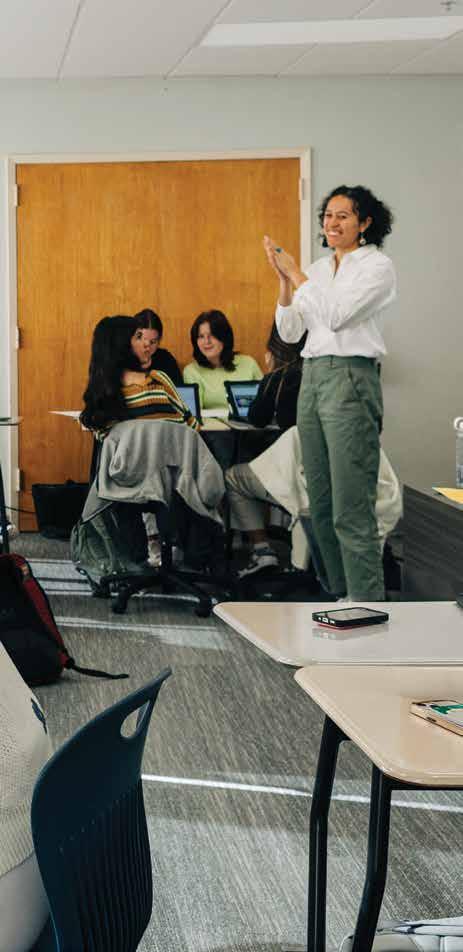
These stewards of our mission not only bring patience, energy, and a unique ability to connect with teenagers (no small feat!), but they also have to have the ability to adapt as teaching methods and technology change. Thanks to the Williston Builds campaign, we’ve been able to increase our investment in supporting teachers by an amazing 500% since 2016. These donations allow Williston to offer dynamic professional development opportunities, best-in-class facilities, and competitive compensation to support teachers’ work with students in and out of the classroom.
For science teacher Tyla Taylor—here teaching AP Psychology—professional development opportunities help her evolve her teaching and stay energized.
“Whether I’m taking a day-long workshop or pursuing my master’s degree in psychology, these opportunities allow me to be a student again. I get inspired by the contemporary research that I’m learning about, then I get to bring it right back to the classroom and share it with my students.”

$5.5M
Total raised to support faculty during the Williston Builds campaign
500% Increase of financial support for faculty professional development during the campaign
A sizeable increase in faculty development funds is fueling new opportunities for teachers
When Dean of Faculty Corie Fogg ’99 interviews prospective teaching candidates, one topic invariably comes up: What is Williston’s commitment to professional development? It’s hardly a surprising question, given the pace of developments in academic fields and the appeal of being part of a school community that celebrates learning. Fortunately, Fogg has a reassuring answer. Thanks to gifts during the Williston Builds campaign, the school has been able to increase its support of faculty professional development by a whopping five-fold. In doing so, Williston has vastly expanded opportunities for teaching faculty to pursue graduate-level education, attend workshops and conferences, and more. At right, we asked Fogg to talk about the school’s philosophy, and how professional development has benefited the Williston community.
30
Endowed funds at Williston Northampton that support the faculty
What are Williston’s—and your—priorities in supporting professional development for faculty?
I think professional development should do three things: It should increase student learning and outcomes. It should foster continuous growth for faculty. And it should perpetuate a learning environment grounded in our shared commitment to purpose, passion, and integrity. Many schools have tried a onesize-fits-all approach to professional development, but I want faculty to engage in development that is individually meaningful to them. Does a teacher want to go deeper into a specific content area? Do they want to learn more about a different pedagogical approach? Do they want to go study with someone who’s an expert?
When we bring the faculty together for shared professional learning, their voice should be part of that, too. Last year, for example, we asked teachers what they wanted to learn more about. Based on the answers, we brought in the Tang Institute, out of Phillips Academy, to talk about grading, which has helped us think about the feedback we’re giving to students in writing, in conversation, and sometimes nonverbally. How does grading impact students’ mental health and social-emotional learning? We’ve already seen some changes, with kids feeling a little less anxious—though they’re still regularly checking their grades online, no question! This year, faculty have asked for increased learning around differentiated instruction and learning styles, and again, we want to meet this moment by sharing expertise.
How does this investment in professional development benefit faculty?
When we give faculty the chance to do something meaningful, they become learners, and they bring it back to Williston. There’s a huge return on investment, not only from a financial standpoint, but also from a philosophical standpoint. When faculty go to a conference, for example, they come back and they put that pedagogical change into their classroom. The kids benefit from it.
Can you give some examples of recent professional development?
The range of professional development is quite huge. We’ve had teachers take workshops and attend conferences. We’ve had teachers do self-directed trips to study ceramics or research spoken word poetry. And we’ve had other faculty pursue graduate-level degrees in pyschology, educational leadership, and more. Last year, I was fortunate to be able to earn a certificate in school management and leadership from the Harvard Graduate School of Education and Harvard Business School online. It was a comprehensive program with a series of courses, and I absolutely loved it.
Why is it important for teachers to continue learning?
I feel strongly that if I we want kids to keep learning, we have to have faculty conspicuously learning as well. My hope for Williston is that we can build a thinking community around these new ideas, and
One challenge facing independent schools today is recruiting, hiring, and retaining teachers who have a passion for the traditional prep school model of teaching, coaching, and dorm parenting. In an era of remote
and hybrid jobs, not everyone is drawn to a 24/7 experience with teenagers! And yet, as alums know, this web of relationships with supportive adults is at the heart of the boarding school experience. One innovative solu-
that you’ll see it reverberating across campus: folks getting together at the lunch table and saying, “Oh, I hear you have a great way of starting your classes. Can I come for the first 10 minutes and watch? Or, I heard you’re having a really challenging discussion about issues within Baldwin’s writing. Can I come in and just see how you navigate dialoguing across difference?”
What do you hope happens when teachers come back from doing professional development?
I hope that it’s really meaningful, personal, and resonant, such that they come back and say, “Oh, I want to talk with the whole faculty about this,” or “I want to get my department doing this together.” A faculty who talk with one another about their teaching is a faculty that gets excited and inspired. And, again, the kids see that energy and they’re like, “That’s cool. I see you’re excited. I can get excited about this too.”
How does having a robust professional development program help us attract and retain good teaching candidates?
I can’t emphasize enough how important it is. It is always a question in the interview process. Some candidates go as far as to ask, “What percent of your operating budget is devoted to professional development?” They want examples of what we’ve been doing, so being able to offer faculty a really robust range of opportunities is essential for both recruitment and retention.
tion is Williston’s new Faculty Fellowship Program. Launching this fall, thanks to seed funding from a small group of donors, the immersive two-year program is designed to attract and train recent college graduates
from different backgrounds. An inaugural cohort of three fellows work closely with individual faculty mentors in a program that encompasses teaching, coaching, and residential responsibilities at Williston.
williston builds the campaign for our community
As education evolves, so too must the resources available to faculty and students. Here are just a few of the ways the Williston Builds campaign has recently helped to adapt our spaces and programs for new and innovative ways of teaching and learning.
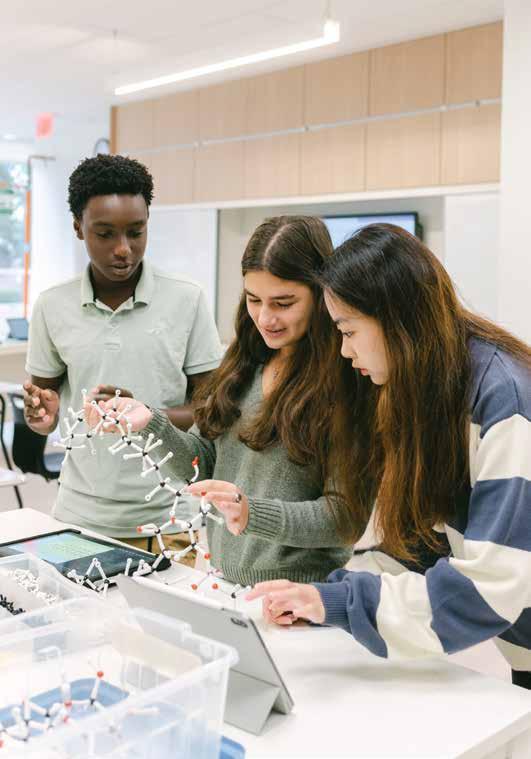
In 2018, Williston’s academic support programs took a giant step forward with the opening of the Center for Academic Success. Located in the lower level of Clapp Memorial Library, the 3,500-square-foot space features two classrooms, two private meeting spaces for one-on-one tutoring, and three learning specialists. Within this space, students can now access an array of extra study tools, including one-on-one and group tutoring, learning strategy sessions, guided study halls, and courses in executive function and study skills. “The new space has opened up so many opportunities for supporting students and helping them them achieve their academic goals,” says Laura Vachet, Williston’s Director of Academic Support. Another way students can now get help? There are newly renovated spaces on the first and second floor of the library for math, science, and writing. Staffed by teachers and student tutors, these resource centers allow students to drop in and ask questions about challenging topics.
Since 1958, generations of students have studied physics, chemistry, and biology in the classrooms of Scott Hall. In 2022, these six hard-working labs got a major overhaul, with a focus on safety, energy efficiency, and creating more collaborative learning environments. In addition to essential updates like improved lighting, ventilation, and new windows, each lab classroom now features movable tables, desks, chairs, and equipment, allowing for flexible configurations and group work tailored to each subject. “The new labs have transformed how we teach,” says Chris Pelliccia, Science Department Chair. “Now we can easily adapt the space for different types of experiments and group activities, which encourages more collaboration and hands-on learning. The flexibility has made a huge difference.” The renovated classrooms also include three sliding whiteboards for group problem-solving, a large monitor for projections, and separate prep spaces where teachers can prepare lab experiments efficiently.

Since 2016, Williston students have been able to meet and collaborate with artists from around the globe as part of the Grum Project. Funded by an alumna from the Northampton School for Girls (the name derives from her NSFG nickname: “Grum”), the Grum Project brings three to five artists per year to campus for mini residencies. “We’ve been able to invite poets, dancers, musicians, actors, painters, even LEGO artists,” says Art Department Chair Natania Hume. “It’s an incredible opportunity for the whole community to get inspired by real working artists.”
Thanks to a gift from the late Robert Sammis ’51, students now have a space—and state-of-theart tools—to make almost any object they can dream up. Set on Reed’s second floor, the Maker Space is home to a laser-cutter, 3D printers, and other digital tools, which students in art, design, and other classes have used to make jewelry, small-scale cities, solar systems, architectural designs, and even prototypes of augmented reality glasses. “With these tools,” says theater production and art teacher Charles Raffetto, “students aren’t limited to what they can physically model. If they can design it on a computer, it can be brought to life, which allows them to test out more theories and ideas.”
During the campaign, donors have funded new theater lighting, tech equipment, and marquees, all of which are helping Williston’s shows to go on—in style. Upgrades to the theater’s main-stage lighting provide energy costsavings, cut down on work for theater techs, and allow for more vivid colors, natural skin tones, and higher-quality white light. The stage crew is also using two new large 3D printers and laser cutters to make everything from stage scenery to a plastic skull for a parody of Hamlet. And finally, what’s a show without some good promotion? Two new outdoor marquees feature dramatic, backlit boxes that illuminate each show’s poster. Bravo!


While some campaign donations have funded new technology, one notable gift has ensured that a Williston institution since 1881 will always endure: The Willistonian newspaper (aka the longest continuously published student newspaper in the country!). With a gift of $250,000, a Northampton School for Girls alumna endowed a fund that will underwrite the paper’s annual operating expenses, including photography, printing, supplies, and technology, for years to come. “The truth has to get out there,” said the donor, who wishes to remain anonymous. “And it has to get out there from people who understand how to write and ask questions.”
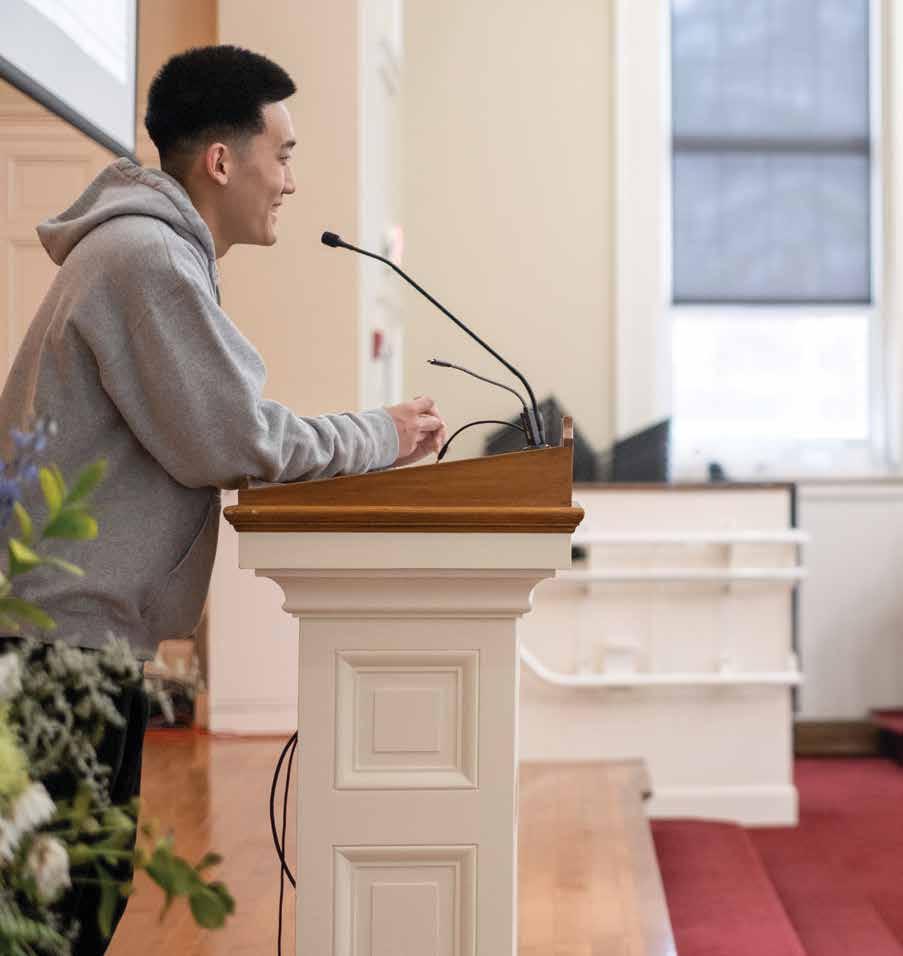
williston builds the campaign for our community


Being part of a diverse, global community is a hallmark of a Williston education.
Alumni often cite the experience of having teammates, roommates, and classmates from different backgrounds as one of the most formative aspects of their time here. Building and sustaining a vibrant, inclusive community of talented students from across the socioeconomic and global spectrum requires significant resources for financial aid. More than $9.6 million in new gifts through the Williston Builds campaign coupled with strong investment growth has doubled the endowment’s support for need-based financial aid—taking it from $10.8 million to $22.1 million.
At left, Jason Park ’25 shares his family’s Korean traditions during a Lunar New Year assembly in Phillips Stevens Chapel. “Ensuring that every student, regardless of their background, feels a sense of belonging is essential to building a strong community at Williston,” says Dean of Students David Koritkoski.
williston builds the campaign for our community

Donations in support of financial aid are expanding access for students—and building a stronger community
Every year, as Williston’s admission officers review applications from hopeful students around the world, they think long and hard about the unique makeup of each incoming class. “We’re looking for students who are talented, kind, and community-oriented,” says Dean of Enrollment Management Chris Dietrich. “But we’re also seeking students who aren’t all the same—those who bring diverse backgrounds, talents, and perspectives that make our community stronger and livelier in all kinds of ways.”
The ability to offer financial aid is essential to creating this diversity and helps Williston remain competitive with other schools. That’s why gifts in support of financial aid have been a top priority during the Williston Builds campaign. More than 40% of students receive financial aid each year—an annual investment of $7 million. The goal of ensuring that students can access a Williston education regardless of financial need resonated with many donors, with more than $9.6 million in new gifts made in support of financial aid dur-
ing the campaign (you can read about one especially impactful gift at right). For many donors, their contributions stemmed from their own experiences receiving financial aid as students.
“Williston was one of the biggest opportunities of my life,” says Brandon Diaz ’12, reflecting on the financial aid package that made his education possible. “I don’t feel that talent or ability discriminates by socioeconomic class, so helping others gain these transformational opportunities is an investment I really believe in.”
Campaign gifts have helped to double the portion of Williston’s endowment dedicated to financial aid. “That’s exciting,” says Head of School Robert W. Hill III, “because it means we’ll always have funds set aside for this purpose, and those funds can grow within the endowment in perpetuity.” He adds, “Financial aid lets us open the door to students. Their time at Williston gives them the purpose, passion, and integrity to do the rest.”

The largest gift in school history is helping create a more diverse student body for generations to come
Longtime champions of Williston, Henry Liss ’42 and his wife, Amy C. Liss, were passionate about philanthropy—especially when it came to helping students from all backgrounds access a great education. During their lifetimes, they established the Henry R. ’42 and Amy C. Liss Scholarship—which supports needbased financial aid for students of color —as well as a faculty professional development fund that also bears their name. Now, thanks to a $6.7 million bequest from their estate—the largest single donation ever made to Williston Northampton—their generosity will make these two endowed funds the biggest at the school.
After Williston, Henry served as a hospital corpsman in the U.S. Navy during World War II, and eventually became a pioneering neurosurgeon. The GI Bill, which provided veterans of WWII with funds for a college education, allowed Henry to attend both college and medical school without incurring any costs. “Henry came to realize how fortunate he was in having the GI Bill,” said Amy in a 2019 interview. “Students don’t always have that kind of support.”
While they supported many causes, Henry and
Amy’s commitment to financial aid remained constant. Amy, who served as a Williston Trustee from 1992 to 2005, was also known for her extensive volunteer work in libraries, literacy, and women’s rights. After Henry’s death in 2006, Amy remained actively involved with Williston until her own passing in 2021.
“While I never had the privilege of meeting Henry, I knew Amy well and enjoyed our frequent conversations about schools, politics, and much more.” recalls Head of School Robert W. Hill III. “Amy was a force—sharp, inquisitive, and never one to shy away from asking the tough questions. She understood the complexities of running a boarding school, and pushed me to think critically.”
With half of the Liss’ bequest allocated to needbased financial aid for students of color, that fund will generate upward of $180,000 in financial aid each year in perpetuity. This will help sustain Williston’s annual $7 million investment in needbased financial aid. “Alumni often tell me they wouldn’t have been able to attend Williston without financial aid,” notes Hill. “It’s a crucial part of who we are as a school. Henry and Amy’s incredibly generous gift ensures that future generations continue to have those same opportunities.”
BY THE NUMBERS
$9.6M
Total dollars given in support of financial aid during the Williston Builds campaign
2,881
Gifts given in support of financial aid during the Williston Builds campaign
105%
Increase in dollars in the endowment earmarked for need-based financial aid since the start of the campaign
146
Endowed funds supporting financial aid at Williston
42%
Percentage of students receiving some form of financial aid in 2024-25 $7M
Total dollars awarded in needbased financial aid this year

How Williston’s new financial aid initiative is helping to create a sense of belonging
Standard financial aid packages have traditionally covered the base cost of attendance— tuition, room, board, and sometimes books. However, many colleges, universities, and private schools are now recognizing that these provisions don’t fully account for other expenses students and families face. “Team sweatshirts, prom tickets, graphing calculators, SAT fees, even money for laundry,” explains Director of Admission and Financial Aid Lee (Dangleis) Greener ’06. “These kinds of costs add up and can significantly impact a student’s ability to learn, thrive, and feel like they belong here at Williston.” During the Williston Builds campaign, donors rallied around this vision, contributing more than $2 million to provide supplemental financial aid to families with a very high level of financial need. At right, we asked Greener to tell us more.
How did this initiative get started?
The need for supplemental financial aid has always been present at Williston and among our peer schools. Williston has a proud history of socioeconomic diversity, rooted in its founding principle over 180 years ago: that a first-class education should be accessible to all qualified students. But for some of our students from high-need backgrounds, extra costs associated with student life, athletics, academics, and college preparation can impact a student’s ability to fully participate in extracurriculars or even just join friends for an off-campus meal. When the Williston Builds campaign began, we saw an opportunity to create an initiative to address these needs. It also aligned with ongoing discussions on campus about fostering a stronger sense of belonging for students. We wanted to make sure that students from lower-income backgrounds could fully experience campus life and the opportunities here without being disproportionately burdened by hidden costs.
How did donors help bring this idea to life?
Recognizing the need was a crucial first step, but Williston lacked the resources to go farther. We already cover 97% or more of tuition-based financial aid for students with very high financial need— typically about 15 to 20 students per year. So we collaborated with the Advancement team to design a pilot program. We outlined how supplemental aid would be integrated into the admission process, family communications, and student support over the course of a student’s four-year experience. In 2020,

“When families decide to join Williston, I want them to feel truly welcomed, with the peace of mind that their needs will be met.”
Lee (Dangleis) Greener ’06
we raised $50,000 from alumni donors to launch the Equity Fund, which funded our first cohort of four Equity Fund Scholars. Similar support followed in 2021, 2022, and 2023, but continuing the program required year-to-year fundraising. Building a dedicated endowment was clearly critical for long-term sustainability.
What was the next milestone for the program?
First, in 2021, the family of Sherrie-Ann L. Gordon ’00 endowed a fund in her memory: the Sherrie-Ann L. Gordon ’00 Equity Fund for Social and Diverse Experiences. Sherrie was an honor student, class President, and epitomized what it meant to be a Williston student. Sadly, her life was cut short in 2015 when she passed away from ovarian cancer. Her permanently endowed fund now provides supplemental aid to Black students with high financial need. Then, in the final months of the campaign, two anonymous donations of $1.4 million and $500,000 established a new endowed Equity Fund for Financial Aid. This funding not only allows us to maintain the Equity Fund Scholars program, but also supports college-
related costs for students with high financial need, like application and test prep fees or college visits.
How will these funds enhance Williston’s ability to attract top students?
In the past, we’ve lost students to schools that already offer comprehensive financial support, including supplemental aid. Many families consider finances a primary concern, and some have told us, “We can’t afford to turn down another school that’s covering all these additional expenses that matter to our family.” These funds help Williston compete for students who would thrive here.
What do you you hope the long-term impact of this initiative will be?
When families choose Williston, I want them to feel truly welcomed, with the peace of mind that their needs will be met. Many high-need students are acutely aware of the sacrifices their families are making for them. I hope this program alleviates some of that pressure, allowing students to fully engage in the Williston experience without adding financial burden or anxiety.
The true cost of being a student can be surprising. Here are some recent examples of costs covered by the Equity Fund for students with very high financial need.
• Train tickets home on long weekends
• TI-84 Calculators— an essential tool for nearly any math class at Williston
• Athletic equipment and team gear
• Weekly laundry costs in the dorm
• SAT and ACT test preparation fees
• College application fees
• Clothing costs tied to dress code requirements, especially for formal events
• Costs of visiting prospective colleges
• An occasional meal off-campus with friends


You can’t see a stronger financial foundation, but you sure can feel it on campus.
Thanks to the generosity of more than 5,000 donors, Williston not only met but exceeded its original campaign goals—raising more than $86 million, increasing the endowment by 64%, and achieving 58% growth in the Williston Northampton Fund. These milestones have created a ripple effect across every aspect of the school, enabling Williston to envision a more ambitious and creative path forward. “I’m so proud of what we have accomplished. Williston has never been stronger,” says Board Chair John Hazen White Jr. ’76. “This campaign has taken the school to new heights. And the stronger we are as a school, the more successful we can be in launching students into the next chapter of their lives.
“A strong financial foundation allows you to dream big,” says Head of School Robert W. Hill III. “It allows you to account for the unexpected and to be creative and flexible about supporting students and faculty in all the ways that are so important.”
williston builds the campaign for our community
How the growth of the Williston Northampton Fund is making great things possible
If you find yourself a bit confused when you hear the term Williston Northampton Fund, you’re not alone. While this fund is vital to the school’s financial health and the day-to-day experience of students, it’s not always clear how it works or why it matters. Here, we explain the nuts and bolts—and how the remarkable growth of the Williston Northampton Fund has been central to the campaign’s success.
What exactly IS the Williston Northampton Fund?
Like many schools, Williston relies on more than just tuition to cover the annual cost of educating students and operating the school. This is where the Williston Northampton Fund plays a key role! Along with tuition and revenue generated from our endowment, this fund helps bridge the gap between income and total expenses each year. Without it, the school would have to draw even more from the endowment, slowing its growth over time. To use a simple analogy, it’s like borrowing from your 401(k) to cover household expenses—less than ideal for long-term financial health. Thanks to the Williston Northampton Fund, we can preserve and grow the endowment for future generations while funding what’s needed right now.
What does the Williston Northampton Fund pay for?
Think of it as a checking account that provides funding where it’s most needed each year—whether it’s fixing a roof leak in Ford Hall, buying new nets for Lossone Rink, covering costs for a field trip, or providing new costumes for school plays or lab equipment. Donors can earmark their gifts for what matters to them—academics, arts, athletics, DEIB, or financial aid—or they can choose “general need,” allowing the school to allocate funds where they’re needed most. Donations are put to work immediately in the year they are received.
Did gifts to the Williston Northampton Fund increase during the campaign?
They did—by an impressive 58%! More than 5,600 donors contributed during the campaign, resulting in more than $19 million given to the fund. As noted above, those gifts were used right away to enhance all aspects of student life and learning at Williston. See more details at right.
The Williston Northampton Fund has seen record growth during the campaign

$19,611,686
Total contributed by Williston Northampton Fund to the campaign… 58%
…representing 23% of the $86 million campaign total
23%
Growth in dollars to the fund since campaign launch
Members of the 1841 Society* increased by 56%
All gifts had a huge impact
5,605
Unique donors who made a gift to the Williston Northampton Fund
4,578 donors made a gift of $100 or less, totaling $955,727 99%
Portion of contributors who supported the campaign through a gift to the Williston Northampton Fund
Young alumni showed up in record numbers
27%
Increase in donors from the 15 most recent classes
57%
Increase in Wildcat Club members of the 1841 Society from the 15 most recent classes

88%
Portion of young alumni that give on Founders Day
Since the start of the campaign, recurring gifts grew
350%
One of the most important achievements of the Williston Builds campaign has been increasing the school’s endowment. Here’s a closer look at why a strong endowment matters and how it fuels expansive thinking for the future.
The endowment functions as Williston’s long-term investment account, designed to grow over time through strategic investments and gifts. The larger the endowment becomes, the more it can support Williston’s mission through regular distributions. Over the past decade, Williston’s long-term investments yielded annualized interest returns ranging from 6.9% to 23.6%, depending on the market. The endowment is invested across diverse assets, including equities, indexed funds, bonds, and real estate.

During the campaign, the endowment achieved steady growth, rising from $36.6 million to $60.2 million—a 64% increase—thanks to a combination of philanthropic support and investment growth.
Williston’s endowment is not just one fund. It’s made up of a general fund (that can be used for any purpose) and nearly 300 endowed funds established by alumni, families, and graduating classes. These individual funds are often earmarked for specific priorities that reflect the donors’ interests and Williston’s mission, such as financial aid, faculty support, athletics, arts, or academics. Many funds carry the names of individuals, classes, or groups they honor—for example, the Northampton School for Girls Instructorship or the Class of 1968 Financial Aid Fund. Twenty-four new endowed funds were established during the campaign, and the vast majority of $26 million in confirmed future commitments from planned gifts will eventually be added to the school’s endowment.
Williston’s endowment provides essential support across all areas of the school’s mission, focusing on long-term goals and financial stability. On average, the school draws about 5% annually from the endowment to supplement tuition revenue, funding areas like financial aid, faculty support, and campus improvements. This is where endowment growth is critical: The larger the endowment, the faster it can grow, and the more income it can generate. A strong endowment allows the school to plan ambitiously and respond to future opportunities with confidence. (See below for an illustration of how a 5% disbursement varies depending on endowment size.)

It’s simple math: A larger endowment generates more income each year, which increases the funds Williston can spend annually. Below, see how a 5% withdrawal grows as the endowment total rises.

• Provides stable income for the future
• Supports costs that tuition alone cannot cover
• Helps the school weather ups and downs in the economy
• Allows Williston to embrace ambitious plans and future goals
• Ensures long-term funding for core priorities
• Creates opportunities for donors to make a lasting impact

“The best part of my job is getting to know these amazing young people and helping them develop their academic interests, personal strengths, and passions. This kind of exploration and learning is possible for faculty as well. The support I’ve received—from mentoring to funding for faculty professional development opportunities, including pursuing my master’s— has been unmatched and allows me to bring my learning directly into the classroom to share with my students.”
—Tyla Taylor, science faculty and recipient of the Sandra B. ’55 and Joseph C. Mesics Instructorship

“Slightly unnerving and a bit spooky.” That’s how longtime visual arts teacher Ed Hing ’77 describes the process of recreating his father’s stories by blending AI and self-portraits. Read more about his recent exhibit on page 42.


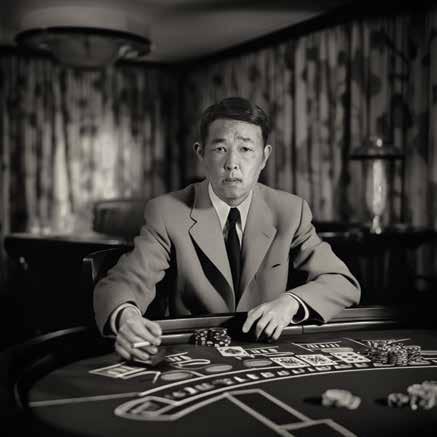
BY DENNIS CROMMETT
Think for a moment of a story you’ve heard throughout your life: how your father drove in the winning run in a baseball game, for example, or how your mother traveled to India as a teenager. Hearing these stories, you’ve no doubt taken someone else’s memories and wrapped them in a visual context, imagining the dirt on your father’s uniform, the places your mother had seen. What if you could hold these images in your hand?
With his new series, ‘Self’ Portrait, aka You Look Just Like Your Father, longtime Williston photography teacher Ed Hing ’77 has accomplished pre-
cisely that. This summer, Hing spent time with his mother, now 97, “trying to get her to share memories before they disappear,” Hing writes in his artist statement. “One of the things she keeps bringing up is how much she thinks I look like my dad. There are almost no photographs of him in our family albums.”
What resulted from those conversations was a deep dive into AI photo manipulation—a release from “photographic reality,” as Hing puts it, culminating in a set of photos depicting Hing’s father in places Ed had only heard about: at a card table in San Juan, arriving at Ellis Island, and more.
Hing began by entering multiple interations
of AI prompts into the application Midjourney. Once the background images were complete, he took a set of self-portraits, which would serve as his father’s face in the composite photos. For this, Hing attempted to match the quality of the illumination, angle, head position, and shading of the background images he had created using AI. Last, Hing worked extensively in Photoshop to marry the background images with the photos of his own face to create the final composites. The final series of framed digital prints, on display in the Grubbs Gallery this fall, brings the stories of his father to life, in a way never before possible. “I can feel my father’s presence when looking at the images,” Hing writes.
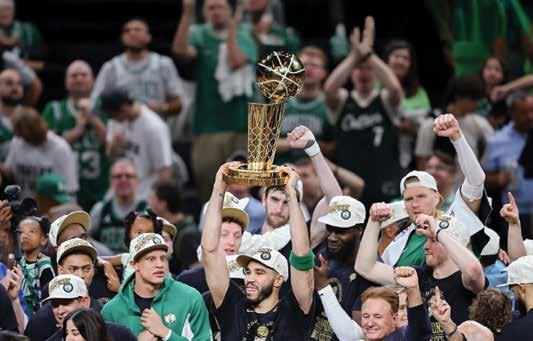
Brittany Glenn ’07 has worked her way up with the Celtics en route to winning banner 18 BY GEOFF
SMITH ’07
Winning a championship in professional sports takes determination, hard work, and a dash of luck. Building a career as a director with a professional sports team requires much of the same, as Brittany Glenn ’07 discovered on her path from Williston to the Boston Celtics organization—a journey that culminated last June in the team’s 18th NBA championship.
Raised in Easthampton, Massachusetts, Glenn has a long history with the franchise. Her father, Norman, a longtime Celtics fan who had grown up in Boston, passed along his passion to her and her sisters (Ashely ’03 and Danielle ’10), beginning with their first game in Boston one Easter weekend when they were girls. “I just fell in love with the Celtics,” Glenn recalls. “To grow up and have my dad teach me about the original Garden and all of the team history, and to see how much my working for the team meant to him, that’s probably been the most rewarding part.”
But a love for the Celtics didn’t translate to a desire to work for the team. Although she was athletic, playing field hockey both at Williston and later at Bryant University in Rhode Island, Glenn initially thought she would pursue a career in accounting.

Brittany Glenn ’07, with the Larry O’Brien trophy after the Boston Celtics won the 2023-24 NBA Championship.
Then, in her junior year at Bryant, she scored an internship with the Celtics. Introduced to the internal workings of the sports world, Glenn began considering a new career after graduation. There was just one problem: The NBA was in a lockout, and the Celtics weren’t hiring.
So, she changed course again, heading back to Western Massachusetts and Springfield College to pursue a master’s in sports management. Just when it looked like the door was closed on a career with the Celtics, she got her dash of luck. The lockout ended, the team was hiring again, and Glenn landed a job in 2012 as a Corporate Partnerships Activation Assistant, beginning as a receptionist and assistant. “A lot of people in my circle thought I was a little crazy to take such a leap,” Glenn says. “But I knew that it was my opportunity to get in. I knew that was how I was going to start my career here.”
And she has not looked back. Over the next 10 years, Glenn would earn six promotions through the front office, landing as Senior Director of Member Experience, Retention & Operations. Her role’s top priority, she explains, is overseeing the experience of season ticket members—the Celtics view their most loyal fans as more than just season ticket holders—“and everything that comes with that,” from a member’s arrival at the TD Garden, to the process
of finding their seat, to the exclusive access and benefits they receive. “You’re paying for a membership that gets you more than just tickets,” she explains. That role in shaping the game-day experience has given Glenn a profound respect for what it means to be a fan. “I tell my group all the time, we’re like Disney World,” says Glenn, who works as part of a 15-person team. “We have the magic of bringing someone onto the court for pregame. For me to be able to be part of something like that is special.”
After the Celtics defeated the Dallas Mavericks for the championship last June, Glenn could take stock of all that she’s accomplished. “To be here as this team has continued building itself is what’s made this championship even more special,” she says. “I was fortunate to be a part of the grind of getting to winning and everything that it takes. The ultimate goal is to win a championship, and even though we’re on the business side, there are things we do to help win.”
Going into the new season, Glenn finds herself in a great position. With room to grow inside the organization still, Glenn knows she’s found home. “I’ve grown up here and I’ve grown here,” she says. “I feel very fortunate to be part of such a special organization. I don’t know how you could walk away from a team like this unless you had to.”
A by-the-numbers look at recent alumni highlights BY GEOFF
SMITH
’07

Flight hours logged by Shearee Zangmo ’20 in a Robinson R44 helicopter. After graduating during the pandemic, Zangmo traded virtual learning for the very real classroom of a helicopter cockpit, learning to fly so she she could start a business in her home country of Bhutan. Now a student at Columbia University, Zangmo is still flying and building her business.
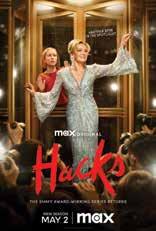
Emmy win for Genevieve Aniello ’09, a producer for the series Hacks on Max. The show, which follows the dark mentorship between a legendary Las Vegas comedian and an up-and-coming comedy writer, won a 2024 Emmy for Outstanding Comedy Series.

20Works on display in “Whippersnappers,” the new exhibit by artist Maya Freelon ’01. Mixing photographs, monoprints, and paintings from the U.S. Library of Congress with her signature “bleeding” tissue paper technique, Freelon’s “Whippersnappers” installation reimagines the lives of enslaved children. The exhibit is on display in Durham, North Carolina, at historic Stagville—formerly one of the state’s largest plantations. “Through ‘Whippersnappers,’ I want to use the healing potential of art to shine a light on a subject often ignored and reclaim a space that was once used to disempower and oppress,” Freelon explains in her artist statement. “If we give voice to the voiceless, we have the power to redefine our collective history.” Find out more at mayafreelon.com

Years playing the bagpipes for Tom Duffus ’78, a competitive piper who showed up to Williston with his Highland bagpipes in tow. Duffus has performed in the World Pipe Band Championships in Scotland and many other competitions. Read more about his piping journey at williston.com/bulletin
Rushing yards for Jayden Clerveaux ’23 during a two-game span for Holy Cross football this past fall. A sophomore for the Crusaders, Clerveaux excelled in two games—a win over Fordham and a narrow loss to Harvard. Against Harvard, Clerveaux scored two touchdowns on 165 yards rushing. The successive 150+ yard efforts earned Clerveaux back-to-back Player of the Week honors in the Patriot League.

Varieties of wines for sale by A Wild Idea, a winery started by Conrad Johnson ’74 in Argentina. Johnson’s vineyards produce a range of wines, including Bordeaux blends, malbecs, merlots, rosés, cabernet sauvignon, and petit verdot. The company’s motto is simple: When was the last time you had A Wild Idea? Learn more about the wines and how to order them at awiwines.com
All of Wildcat Nation— and much of the world —was focused on U.S. Olympic sprinter Gabby Thomas ’15 as she took her place at the starting line at Stade de France last August 6 for the finals of the 200-meter event. Just 21.83 seconds later—and she had won the first of her three gold medals (victories in the 4x100 and 4x400 relays would follow). Her expression—fierce exuberance blended with elation at realizing a long-pursued dream— had all of Williston sharing in her glory. In an extra-meaningful moment of Wildcat magic, one of the first to congratulate her after the race was her Williston track coach, Martha McCullagh.


Brendan McCartney ’08 is using his
BY KEVIN MARKEY
Aleading developer of wind, solar, and energy storage across the United States, Apex Clean Energy is on a mission to accelerate the country’s shift to renewables. Working at utility scale—think power plants, not rooftop panels—the Charlottesville, Virginia-based company finances, designs, builds, and operates facilities that are on track to displace some 690 million tons of carbon dioxide from the atmosphere and generate enough electricity to power 3 million American homes. After a finance career that has included investment banking and security trading for the Federal Reserve Bank of New York, Brendan McCartney ’08 became increasingly drawn to the clean energy market and joined Apex three-and-a-half years ago. He and his wife, Jillian (and their Great Dane, Marleigh!), now live just miles from where they both studied at the University of Virginia. We recently caught up with him to find out more about working on the cutting edge of the renewable energy transition.
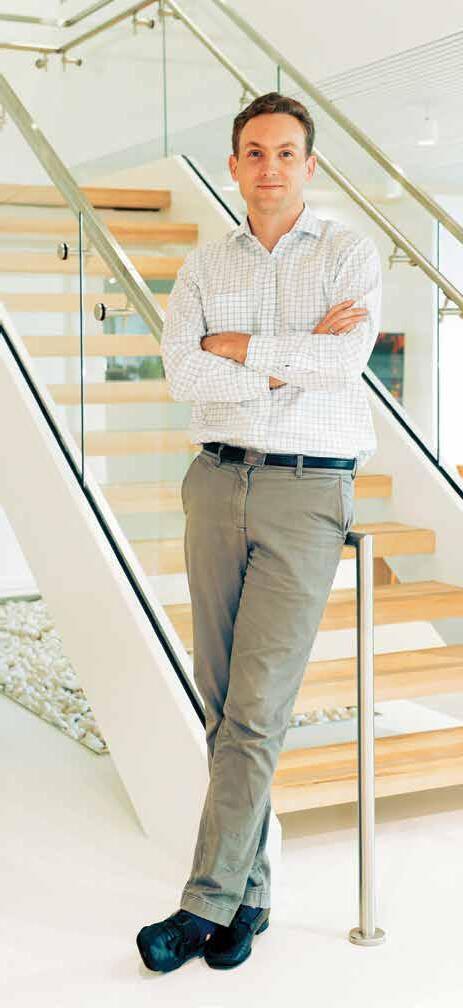
At the end of the day, we’re all working towards one goal, and that’s protecting our planet and trying to leave it in a better place by creating a lower-carbon future.
Your academic and professional background is in finance. What brought you to the green energy industry?
After studying economics as an undergrad at University of Virginia, I worked in investment banking for four years in New York and London. Over the course of that time, I started to develop a specialty in infrastructure—things like airports or toll roads or shipping companies. And one of the things I worked on was an offshore wind project in Germany in the North Sea. I had no prior experience in wind, and I was like, “Wow, this is pretty fascinating. I’d like to do more of this.” I knew I wanted go back to school at some point, and when I did, I found an international finance program at Johns Hopkins that allowed me to do quantitative work in economics with a focus on energy and the environment. It was perfect. I was doing a lot of energy economics and international markets stuff, energy in the Middle East, energy in Latin America, natural gas markets, things like that, and I was interested in combining these things with the functional skill set I had from investment banking. I wanted to work in the renewables space, because I see it as the energy of the future.
What’s your role at Apex?
I’m part of the finance team. My roles and responsibilities involve raising capital, along with business planning and strategy, and investor relations. We set budgets and goals, and that could be anything from a 12-week cash forecast to a 10-year corporate model where you’re doing blue-sky thinking. What drew me to the company is that it really lives by core values of sustainability, integrity, and entrepreneurship. We’re aware that we’re coming into communities as an outsider, and we have a responsibility to be a good partner.
Do you feel a sense of urgency about the work?
I’m not a doomsayer type of person, but there’s a term “tipping point” in conservation and biology, where once the Earth crosses a threshold, you can’t recover back to where it was before. It’s kind of scary, but we can’t treat things as business-as-usual anymore. We need to get more electric vehicles on the road, we need to think about the power demands of artificial intelligence. One of the nice things when I was in grad school, the curriculum was pretty evenly balanced between the energy side and the environmental side. We exist in an ecosystem where one thing affects another. There are always many different factors to consider, and this is what makes the clean energy sector interesting. At the end of the day, we’re all working towards one goal, and that’s protecting our planet and trying to leave it in a better place by creating a lower-carbon future.
What are some of the big challenges?
Our company works within a very complicated grid system. We are what’s called an IPP, an independent power producer. We do not own the transmission lines or the power lines that connect to your house. We’re upstream at the power-generation side. One of the unique aspects about the grid is that energy supply and demand must be 100% matched at all times. Every time you turn on a light switch or a washing machine, there has to be a power source ready to meet that demand. So we work closely with the utilities: “OK, what’s the impact to the whole system if we connect a project to your grid?” In Texas, for example, which is a really strong market for renewables, things have reached a point where the amount of power we’re generating is too much for the grid. There’s something that we call congestion, which is an electrical engineering term, where there’s so much resource being connected that power has to be curtailed. The wind resource is out in West
Texas—Odessa and Midland—whereas the load centers are in East Texas—Houston, Dallas, and Austin. More transmission needs to be built to connect the two, and you can’t just create this capacity overnight. This is one of the biggest bottlenecks to the growth of renewables in every region of the country.
Any exciting projects in the pipeline?
There’s one in New England called Downeast Wind, up in coastal Maine, north of Acadia National Park. Maine is a very beautiful place, and to help keep it that way the state has set a goal of getting 80% of its power from renewable sources by 2030. Downeast will help by generating 126 megawatts of electricity, enough to power 37,000 homes. Throughout the design and build process, we’ve worked closely with residents, landowners, ecologists, and the state to be supportive of the local economy and to expand and protect natural habitats. For example, we take a construction break for the blueberry harvest, which is enormously important economically in the region. We started construction last November, and we’ll finish around the end of this year.
How did Williston help prepare you for your work?
My favorite subject was always history, any sort of history: World Civ, U.S. history, Comparative Politics with Mr. Fay. I took honors math classes freshman, sophomore, and junior years, but as a senior I had a little crisis of confidence, so I didn’t take AP Calc. I dialed it back and took regular calculus. I’m going to be a history major, right? It turned out to be a great decision, because a little way into the year, Ms. Anderson, my calc teacher, said, “You’re better at this than you think you are. I think you should consider majoring in econ in college.” It gave me confidence, and I took math classes at UVA and I loved them. Now most of what I do today is work with numbers.
Betsy Assoumou ’05 finds a new calling—and connects with fellow alumna Cherie Holmes ’75—as a medical resident
BY JONATHAN ADOLPH
Betsy Assoumou ’05 has always valued hard work. It’s a trait she credits to her mother, Jacqueline Gnagne, who in 1989, when Assoumou was 2 years old, emigrated from West Africa’s Côte D’Ivoire to Amherst, Massachusetts, to pursue her Ph.D., and who instilled in her daughter an appreciation for educational achievement. Williston would be just the starting point. By 2017, Assoumou had earned her B.A. in chemistry at Williams College and an M.B.A. in accounting at Northeastern, had built a successful career as an accountant with Boston-area firms, and was serving as Chief Financial Officer for Health Goes Global, an international nonprofit that supports preventative health efforts around the world. But when her mother died at age 62 after a long battle with cancer, Assoumou decided there was more she could do. Trading her corporate office for

the classrooms of the University of Vermont, she earned a master’s in medical science in 2018 and her M.D. in 2024. In July she became one of six physicians in a new three-year residency at Cheshire Medical Center, part of Dartmouth Health, in Keene, New Hampshire. Perhaps not surprisingly, her specialty is family medicine, a field with a notoriously
Upon learning that fellow alumna Cherie Holmes ’75 (right) was also at Cheshire Medical Center, Assoumou recalls, “I instantly felt closer to her because she’s the ownly other woman of color that I’ve met in the system so far. That made it extra special.”
demanding workload. Indeed, Assoumou recalls attending a retreat where the speaker compared family medicine practitioners to dung beetles. “We do the work that isn’t really appreciated, but really does make a difference,” Assoumou explains. “You have to have a certain kind of spirit to do that, and that’s a point of pride for me.”
In what may be a sign that she made the right decision, Assoumou learned soon after arriving at Cheshire that one of the program’s administrators is fellow alum and Williston Trustee Cherie Holmes ’75. Neither woman was aware of the connection until after Assoumou matched, but they have since bonded over their shared experience. “It was a cool thing to discover,” Assoumou recalls. “I instantly felt closer to her because she’s the only other woman of color that I’ve met in the system so far. That made it extra special, like we’ve had a similar path.”
Indeed, Holmes has had her own impressive career journey. A member of Williston’s Cum Laude Society (and a speaker at the 2018 induction ceremony), she earned her B.A. in English at Dartmouth College and her M.D. at Georgetown University, followed by a residency in orthopedic surgery at Harvard and fellowship training in both orthopedic traumatology and sports medicine. She then spent four years in the Navy, including seven months in the Persian Gulf during the first Gulf War, before earning her M.S. in Healthcare Management from the Harvard School of Public Health.
Today, Holmes is Cheshire Medical Center’s Designated Institutional Official for Graduate Medical Education, having previously served as the group’s Chief Medical Officer and Chief of Orthopedic Surgery, among other roles. Cheshire’s decision to create a new residency program in family medicine, she explains, is a response to both the nationwide shortage of primary care doctors, as well as the need for physicians willing to work in rural areas. Assoumou’s interests, dedication, and life experience made her a strong candidate for the program’s first cohort, Holmes notes. “When you’re starting a brand-new residency program, you are looking for people who bring focus as well as maturity,” she explains. “Betsy had done well in medical school, but she had that focus, that drive, that maturity.”
For her part, Assoumou says pursuing family medicine felt like the right response to her mother’s death. “If she had had someone in her corner reminding her to take care of her health, perhaps a lot of the lifestyle things that she ended up dealing with might not have been as severe as they were,” she explains.
That more personalized aspect of family medicine, and the relationships that can develop between physicians and patients over the course of their lives, can be appealing to some doctors, Holmes
notes, helping counter the specialty’s long hours and comparatively lower pay. “You get to see everything about a person,” she says. “And so you have this incredible continuity of care.”
That certainly was a draw for Assoumou, who notes that “family medicine reflects my personality, and the type of care I want to give patients.” And while her mother’s values may have informed her decision to change careers, Assoumou traces
her resilience in part to experiences at Williston. When she was not elected to student government, for example, “that was the first time I learned that you might not always be the choice for something,” she says. “And instead of letting that get you down, you say, ‘OK, what was it that perhaps I need to work on?’ That was something I remember learning there for sure: You work on it, and you move forward. You continue to put yourself out there.”


BY ALEXANDRA KENNEDY

In her 10th cookbook, author and baker extrordinaire Zoë (Neal) François ’85 serves up spectacular cookie recipes that are rich with practical tips and deep personal history
When Zoë (Neal) François ’85 started working on her latest cookbook, Zoë Bakes Cookies, she thought she knew exactly what she was in for.
This was not, after all, her first batch of cookies.
The pastry chef and star of her own Magnolia Network cooking show had already authored nine bestselling cookbooks. Her plan was straightforward: Develop the best cookie recipes she could— delicious and foolproof—write them up, photograph them, and deliver her publisher a beautiful book.
She knew she wanted to include a few of her grandmothers’ recipes in a chapter about holiday cookies, so she reached out to her mother, father, and aunt, hoping to fact-check some of her memories. Those conversations turned out to be a revelation. Over the course of the three years the book was in development, Zoë learned family stories she’d never heard before—stories that went back generations.

“I realized these recipes were not just about holidays,” Zoë says, speaking on Zoom from her home kitchen in Minneapolis, recognizable now to legions of fans. “They were about these people and what they brought to my life through recipes and how that formed me as a person. I learned so much about my heritage and family story—about all these women who are in my DNA.”
Zoë Bakes Cookies launched in September at number 7 on the New York Times Bestseller List. It offers 75 cookie and bar recipes grouped and organized around important people, places, and themes from Zoë’s own colorful life. It’s part rich personal history, part practical recipe guide.
“It was a fascinating journey for me,” says Zoë. “I thought I knew exactly what this book was going to be, and it became something entirely different. And honestly, it’s the book that is most me, and that makes me a little nervous. I mean, I really put myself and my family into this.”



Zoë had a famously peripatetic upbringing, including life on a commune that her father founded in the Northeast Kingdom of Vermont. After attending 14 schools, she finally got the soft landing she needed as a junior at Williston.
“They were some of the most profound years of my life, and there were only two of them! It really changed everything for me,” Zoë says. “I came from such a wild childhood, and Williston was a very secure place. Lots of boundaries.”
Her baking career took root soon after at the University of Vermont, when a class assignment required her to draw up a mock business plan. She chose a cookie cart that would sell fresh-baked cookies to passersby on Church Street, an outdoor mall in Burlington. Eager to make spending money, she decided to turn her fantasy into a reality. Graham, her boyfriendnow-husband, built the cart for her.
Chapters in Zoë Bakes Cookies include “The Vermont Commune,” “Zoë’s Cookie Cart,” and “State Fair and Other Favorites”—a tribute to her adopted state of Minnesota. The soul of the book, though, are the stories about the women in her family—her grandmothers, aunts, great-grandmothers, and great-great-grandmothers who all baked before her.
“Granny Neal’s Christmas Cookie Tin” honors her formidable paternal grandmother, who was of Norwegian descent and—like so many women of her generation—a devotee of Betty Crocker. In addition to Granny’s recipes for ginger snaps, espresso shortbread, and coconut bars, Zoë includes
cookies that honor their shared Scandinavian heritage, like krumkake and almond spritz cookies.
“There were always two things on the table when we came into Granny Neal’s living room on Christmas,” Zoë writes. “A full set of Norman Rockwell books—as if to instruct us on how that holiday was meant to look—and tins of homemade Christmas cookies.” The tins were on every table and in every room. Zoë, who was growing up on carob chips and raisins at the commune, was transported.
“Bubbe Berkowitz’s Cookies,” a chapter featuring recipes for Jewish delicacies like mandelbrot, hamantaschen, and rugelach, pays homage to Zoë’s maternal grandmother, Sarah. While researching the book, Zoë discovered that Sarah’s own grandmother, Shaindel Siro, lived in a Jewish ghetto in Kiev, where she baked sweets in her home kitchen to bring in extra income.
By the eve of the Russian Revolution, though, Shaindel was in a dire situation. Her husband had been killed in a pogrom, and she was desperate to get her children out. Her fearless teen daughter Sonny began secretly filching flour, sugar, and salt from the kitchen cupboards to sell to the Russian soldiers in nearby camps. Once she had saved enough money for the fare, she shipped her older sister Zelda off to New York City, where she got a job baking in a restaurant. One by one, the whole family made it out. Settling down in Brooklyn, Shaindel started selling sweets again from her new apartment. Zoë was born to bake.
Zoë does not have an assistant, preferring to develop recipes alone in the quiet of her home kitchen with her
After growing up on a Vermont commune (inset, left), Zoë had her first foray into baking with a cookie cart in college (right). Above, one of her many family recipes: Bubbe Berkowitz’s Rugelach. “Her cookies meant pure love,” says Zoë.
two poodles at her feet. She also styled and photographed all the cookies in the book herself, all the while keeping up with fans online. Or at least she tried to: She has 429,000 followers on Instagram alone.
At a virtual prelaunch event in August, hundreds of fans logged in to watch Zoë bake madeleines and to ask their questions. Graham, who works as a director for a technology company, cheered her on from behind the camera. As she pulled a hot tray from the oven, more questions came rolling into the chat every few seconds: “How different is almond meal from almond
flour?” “Where did you purchase the wooden board on your island?” “Do you have a new show we can watch?”
Zoë still exudes all the enthusiasm of that college student behind the cookie cart. She has a mile-wide smile and springs around her kitchen like she’s on her toes. Somehow, for an hour, she managed to answer dozens of questions, make a batch of golden madeleines start to finish, and talk about her family history. Holding a spread from the Bubbe Berkowitz chapter up to the camera, she explained that as a young woman she asked her grandmother to write down
her family’s cookie recipes. It never occurred to Zoë, though, how fortuitous that was until she started interviewing her mother for the cookie book. Her great-great-grandmother, Shaindel, could not read or write.
“When I asked my grandmother to write them down, it was the first time they were ever on paper,” she told the rapt audience. “They had been told verbally from one generation to the next. And if I hadn’t asked for those recipes, they’d be gone. I learned from this book to write these things down, to ask the questions, to ask for these stories.”
My favorite cookie from the 1980s has evolved over time as I’ve ramped up my skills and perfected my tips and techniques. This version is my perfect chocolate chip cookie. The beauty of this recipe is that it is meant to change according to your mood. I’ve even changed it since it appeared on my TV show and blog. It’s the perfect example of how fluid baking can be, which is exactly what makes it so fun and exciting.

Baker’s Note: My husband likes a cookie with more dough and fewer pools of chocolate, so I make some with less chocolate for him and then dump the rest in for me. You can adjust to how much you like.
Makes about 20 cookies
2 ²⁄³cups / 320 grams all-purpose flour
1 ¼ teaspoon baking soda
1 ½ teaspoon kosher salt
¾ cup / 170 grams unsalted butter, at room temperature
¼ cup shortening
1 cup / 200 grams granulated sugar
1 ½ cups / 300 grams lightly packed brown sugar
1 ½ teaspoon vanilla extract
2 eggs, at room temperature
8 to 12 ounces / 225 to 340 grams bittersweet chocolate, chopped in largish chunks
(about ¼ inch / 6 mm)
Flaky sea salt for finishing
In a medium bowl, whisk together the flour, baking soda, and salt. Set aside.
In a standing mixer fitted with the paddle attachment, cream the butter, shortening, granulated and brown sugars, and vanilla on medium speed until creamy, about 3 minutes.

Zoë’s grandmother Sarah Berkowitz (right) was the keeper of many prized recipes. She’s pictured above in Brooklyn with her sister-in-law Rose (left) and her grandmother Shaindel, a baker who immigrated from Kiev.
Add the eggs, one at a time, beating on medium speed until incorporated. Mix in the chopped chocolate pieces. You may need to give the bowl a couple of swipes with a rubber spatula at the end to make sure the chocolate is evenly distributed.
Line a baking sheet with parchment paper. Scoop the cookie dough using a #20 (3-tablespoon) portion scoop onto the baking sheet. You can make the cookies larger or smaller, but it will affect the baking time.
Refrigerate the dough balls for at least 30 minutes; but if you have the time, they improve if you let them sit for 24 to 26 hours. After they are chilled, you can bake them or freeze the dough balls for baking later.
Preheat the oven to 375°F / 190°C. Line a baking sheet with parchment paper.
Evenly space six chilled cookie balls on the prepared sheet and sprinkle them with flaky salt. Bake in the middle of the oven for about 12 minutes or until golden brown and slightly puffed. Repeat with as many batches as you need.
Allow the cookies to cool slightly on the baking sheet, until you can move them without them falling apart, about 5 minutes. Then move them to a cooling rack to finish cooling.

For Kaden Green ’23 and Caleb Boyko ’23, the idea for their high-flying start-up dates back to an unusual spot: the Williston library
BY JONATHAN ADOLPH
The tech world has more than a few stories of businesses dreamed up in a college dorm room. But it’s the rare start-up that can trace its origin back to boarding school. Consider, then, the remarkable story of Escape Aviation, a private-jet brokerage company founded by Kaden Green ’23 and Caleb Boyko ’23 in 2022, when both were still students at Williston.
“We called ourselves GBC Jets, and we would sit in the library and try to work on trips,” recalls Green, a Northampton, Massachusetts, native
now studying entrepreneurship and international business at the University of Miami. A pilot since age 14 with a longtime interest in aviation (his Williston Scholar senior project explored the safety of the airline industry after 9/11), Green had been introduced to the world of private jets through his uncle, a New York businessman who had asked his nephew for help booking flights. Boyko, a boarding student from Belchertown, Massachusetts, now studying finance at Texas Christian University, shared Green’s passions for both aviation and business. “By junior
year, Caleb and I decided that we really wanted to take this seriously. So we hired a lawyer and created an LLC with the name Escape Aviation.” Along with a third partner no longer with the company, each put in an initial stake of $1,500.
Two years later, Escape Aviation is on the ascent, with four employees, more than a hundred clients around the world, and even a companysponsored polo team in Greenwich, Connecticut. Not bad for a business whose founders manage operations as they attend college—or, during the
summer months, from the bedrooms of their family homes.
“We get some funny looks here and there when clients learn the company’s story,” admits Green. “But we deliver on what we say we’re going to deliver on. And they tell us, ‘Hey, your service is better than any large private jet company I’ve worked with.’ They can text me at any time, and I’ll have whatever they need on the plane. That personal touch is key.”
Indeed, the pampered world of private-jet aviation bears little resemblance to commercial air travel, with
its long security lines, delayed flights, cramped seats, and numerous other indignities. Just as a high-end house can be rented out through AirBnb, the owners of luxury aircraft—generally corporations—offer their planes to be chartered when they are idle or are returning empty from a destination. Brokers such as Escape Aviation, with the help of subscription software that tracks available aircraft, match jets to clients who are willing to pay for a personalized and far more comfortable experience.
Given the hefty price tag—often more than 15 times the cost of a firstclass fare—private jet charters have always attracted a limited clientele. But during the pandemic, from their vantage point in Easthampton, Boyko and Green realized that the market was evolving. “The whole reason we started was because it used to be the one percent that would fly like this,” explains Boyko, who today oversees the company’s finances. “Then, after COVID, there was a big shift in people wanting to fly this way.” Potential new customers could choose from various industry offerings, such as fractional jet ownership or “jet card” membership plans. And there was a surge of demand for jet brokers who arrange flights while also handling catering, car service, and other travel needs.
Entering this crowded field, Escape Aviation has been able to compete with a stripped-down approach. “We don’t have a huge overhead,” explains Green. “We don’t have an office. We don’t have to be adding 25 or 30 percent to every single quote.”
While Escape’s clients may be paying less, they still expect first-class service, which proved challenging for business owners who had actual classes to attend. “Honestly, my grades struggled first and second semester,” recalls Green. “I would be in a
400-person lecture, and all of a sudden, I’d get a call from a client and I’d have to leave to take care of it.”
While Green was in Miami, Boyko had opted to take a PG year at Westminster to pursue his longtime dream of playing collegiate baseball. He too found himself stretched thin. “I said to myself, I don’t think it’s worth it to keep a high school schedule and try to run the business.” He reluctantly left Westminster in December, giving up baseball, and entered TCU last fall.
Fortunately, throughout the company’s launch and growth, both young men have had mentors they could
man’s Facebook post. “He owned an oil pump company down in New Mexico and Texas, and happened to be on there,” he explains. “He did a couple hundred thousand with us that year.”
That drive to succeed is a value that unites Green and Boyko, dating back to when they first met in English class their sophomore year and discovered they had each started businesses as kids—cutting lawns, clearing snow— and planned to work for themselves in the future. In their time at Williston, they say, they both developed the positive work habits that have led to their success. Boyko credits Kyle Hanford
me, ‘You’re going to do really well if you keep asking questions and going to people for help when you know you need it. Don’t be afraid to do it,’” he recalls. “And that correlates to the company, as well, putting in that extra effort, working until 3 a.m. if you have to. Because as a business owner, we have to do that.”
Indeed, the high expectations of the company’s clientele and the need for last-minute travel can be particularly demanding on the company’s young founders. At the same time, building personal relationships has brought its own rewards. They often dine with
“We get some funny looks here and there when clients learn the company’s story, but we deliver on what we say we’re going to deliver on.”
turn to for guidance and support. For Boyko, it is his father, Andrew Boyko, who owns a Belchertown wire-splicing company. Green, in turn, has his grandfather, New York real estate developer Stephen Green. “I got a bunch of advice from him,” Green says of his grandfather, whose SL Green Realty is Manhattan’s largest office landlord. “Even though we’re at a totally different scale, at the end of the day, a lot of the decisions are very similar.”
One early business decision the pair made has paid off significantly. To gain exposure and reach new customers, they exploited the connecting power of Facebook. Green recalls how he got one of his biggest clients last year by replying in the comments of the
’97, his freshman advisor— “He’d always tell us to be ourselves” —and his economics teacher Teddy Schaffer, who knew he and Green ran a company and “was always willing to help us out.”
Green cites the support he received from his advisor Monique Conroy when he first transferred as a sophomore. But it was his struggles in a history class taught by Sarah Klumpp that helped him develop an approach to problems that he still uses today. Green had been repeatedly asking for extra help, and Klumpp was reassuring. “She said to
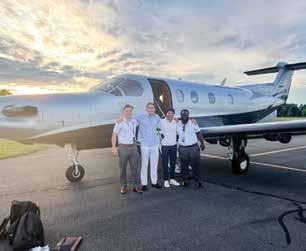
clients around the country, or meet with them on their chartered jets, and have developed connections “that go beyond business,” Boyko notes. All of which serves to remind the pair that they have come a long way from their days in the Williston library. As Green puts it, “Sometimes Caleb and I are thinking, ‘What are we doing?’”


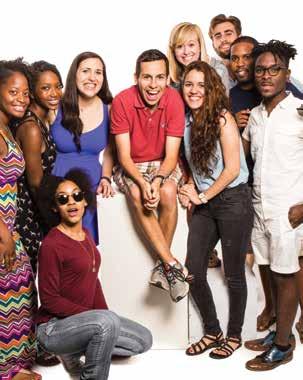

Wildcats showed up in record numbers for events last year, and the finale was an epic, confetti-filled Reunion 2024. More than 396 alums and guests had a great time reminiscing, raising a toast, dancing, and—most importantly— reconnecting. Flip through the following pages to see more highlights and find out why alumni (including the class of 2014, above) had so much fun.
Wildcats, props, and confetti cannons—oh, my! Our always-popular Reunion photo booth brought out the smiles under the big tent this June.







Fun was most definitely had at Reunion 2024! Here are 10 favorite moments from the weekend (check out Williston’s Flickr for many more!).


The classes of 1974 and older celebrated their big milestones with dinner and toasts. At left: Lansing Pugh ’69 and Andy Solomon ’59. Above: Heather Harts’horn ’74 and Carl Alford ’74.

PORTRAITS AT REED
The caricature artists on the Reed Terrace were busy making souvenir sketches—like this one for Monet (McCorvey) Gaines ’94 and J.R. Gaines.
Alums of all ages had fun borrowing bikes for a spin around campus and town. The tandem bike was an extra-big hit for the kids of Christine (Eaton) Callahan ’99 and her husband, Dan.

MARK AND MO
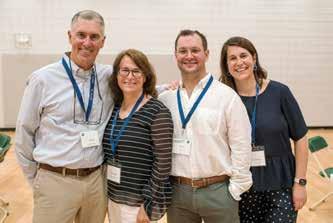
Speeches, toasts, laughs, and a few tears marked the retirement party for Mark and Monique Conroy on Friday night. Pictured from left: Mark, Monique, Kevin Conroy ’12, and Kristina Conroy ’10.

Alumni

CLOSEST TO THE PIN Golfers and nongolfers alike gathered near the Victory Bell to try and land shots closest to the “pin” on the other side of the pond. Zach Pyser ’14 took home bragging rights.

The Adirondack chairs and firepits around campus were a huge hit for alumni, offering the chance to gather in smaller groups for deeper conversations.
PORTRAITS AT THE PHOTO BOOTH If you didn’t get a portrait taken like the class of 1999...did you even go to Reunion?! Confetti cannons, foam fingers, the Wildcat head, and more were available to commemorate the perfect moment. (See more pics on page 60-61.)
SIP AND PAINT
Always a favorite, the Sip and Paint event brought all Reunion classes together to enjoy a relaxing moment with a paintbrush and wine glass. Pictured here are Robert Peterson and Sandra (Tigh) Peterson ’54.




ATHLETIC AND ALUMNI AWARDS
More than 15 alums and teams took home the hardware after being celebrated for their accomplishments and dedication.
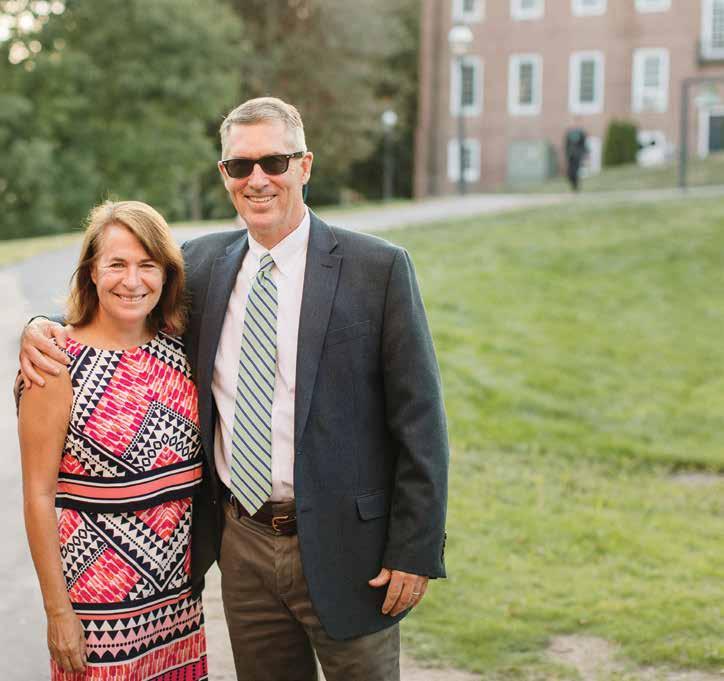
After 48 years of combined service to Williston, Mark and Monique Conroy retired from their positions at Williston this June. Deeply beloved and respected, Mark served as Director of Athletics and head football coach, and Monique as math teacher and soccer coach, among many other roles. But from the reflections sent in by alumni upon their retirement, it’s clear that the Conroys were so much more to students and colleagues. At a campus party in June, two of their longtime colleagues and co-coaches— Matt Sawyer and Jen Fulcher—shared tributes to Mark and Mo. An excerpt of those speeches is below, and you can the full versions at williston.com/conroys
When many of us think about Mark Conroy, his steadfastness, his preparedness, and his diligence come quickly to mind—and those characteristics are part of the fabric of who he is. But I would argue that Mark’s secret sauce is actually his ability to value and celebrate the whole—whether it be a team, or the athletic department, or the Williston community in general—while also having a complete and laser focus on each individual within that whole. I wish all of you could have been there for Mark’s end-of-practice speeches.
The players would be in front of him, breathing a little heavy after some sprints, and Mark would not release them to the locker room before some advice that almost never had anything to do with football. Most famously, he would go silent and look at the foliage while the sun set and urge everyone to do the same (“Boys, I may be biased, but this has to be the most beautiful setting for football in all of New England!”). But more usually, Mark would urge his players to sit in the front row, to talk in class, to get extra help. I remember there were multiple times where Sarah and Will and Anna would be off to the side, waiting for practice to

end to take me to dinner, and Mark would call Sarah over to the group. (“Boys, do you know Ms. Sawyer? She runs the Writing Center. What a TREMENDOUS opportunity you all have to get better at writing! You would have to be CRAZY not to visit Ms. Sawyer in the Writing Center…”). Or, if there was a choral concert coming up and one or two of the players would be singing in it, he would have them stand up and give us a preview. He showed the team how much he valued academics and the arts at Williston. What an amazing message for an Athletic Director and football coach to give.
I know I am a much better school person because of Mark Conroy. Working at an independent school is difficult because the professional and personal lines so often get blurred, but what Mark has taught me over the last 24 years is that success in this world comes from an embracement of that blurriness. I know Mark well enough to know that he is an outstanding husband, a caring father, a tremendous son and brother (and an already doting grandfather). He has modeled for all of us the importance of family. But more than that, he has treated all of us AS family. He treats Williston students like his sons and daughters; he treats all of us as brothers and sisters. I may be biased…but I am also right: Mark Conroy is the ULTIMATE independent school person. Every single day with him was “a great day to be a Wildcat.” —Matt Sawyer
Monique has been at the core of what has made Williston such an amazing place for students for over two decades. She is a role model and mom with every part of her soul, to her own kids and to every Williston kid—whether she taught them, coached them, or cheered for them while running the clock at a basketball game. She exudes caring. She makes them feel safe and supported. I coached with Mo for years, and she was prepared in a way I never was. Any

need a kid had, Mo had the answer or supplies. “Coach, do you have a hair tie?” they would ask, looking at me. Really? But Mo would have one, or find one. A player was hungry. Out of the Mary Poppins backpack came a sealed plastic bag with snacks. You’d think she was sharing her own snacks with them, but no. These were just for kids. I never saw her eat anything out of that bag in all my years with her. She packed what the kids might need—physically, intellectually, and emotionally.
As a math teacher, she was nothing short of phenomenal. In a subject that at times intimidates and overwhelms, Mo created a sanctuary of learning. She had the gift of making mathematics accessible and engaging, which turned students’ apprehension into enthusiasm. Her students didn’t just learn math; they felt empowered by it. She made them believe in themselves, helping them feel smart and capable. Her unwavering commitment to their success was evident in everything she did.
Mo’s ability to connect with students was unparalleled. They sought her advice and trusted her implicitly because they knew she genuinely cared. She had an innate ability to see each student’s potential, even when they couldn’t see it themselves. She was a beacon of hope and encouragement, guiding them through their challenges and celebrating their successes. As an advisor, she played a pivotal role in shaping the lives and futures of countless students.
I have seen her work with students that were close to the edge of giving up on something—a tough subject, a hard challenge, even themselves— and her support was key in helping them stay engaged and ultimately walk through the graduation line with pride and confidence for what the future holds. And behind this growth and change of mindset was Mo. —Jen Fulcher
Among the many celebrations at Reunion are the recognition of alumni who have achieved remarkable things. This year, six distinguished individuals received Alumni Awards for their loyalty, exceptional service, and achievement, and we also inducted two memorable teams, one legendary Director of Athletics, and five accomplished athletes into the Athletic Hall of Fame. For complete remarks, videos, and past winners, please visit williston.com/alumni
WILLISTON
NORTHAMPTON MEDAL
ANN DOWD ’74
Ann Dowd, class of 1974, from Holyoke, was an active participant in theater at Williston, including the Williston Summer Theater in 1973. During her time, she featured as Bea in A View From the Bridge and Miss Adelaide in Guys and Dolls. Over the past 50 years, she has built a distinguished acting career in TV, film, and theater.
Ann is best known for her Emmywinning role as Aunt Lydia in The Handmaid’s Tale and received another nomination for her role in HBO’s The Leftovers. Her film performance in Compliance earned her a National Board of Review Award. She has also excelled on stage with performances in Broadway and o -Broadway productions, including The Seagull, Doubt, and The Normal Heart. Ann served as Williston’s Commencement speaker in 2019 and has been a valuable mentor to theater students.
Charles (“Charlie”) Carroll, class of 1979, was a standout varsity athlete at Williston, participating in soccer, lacrosse, swimming, and hockey, and was also involved in theater and the Caterwaulers a cappella ensemble. After graduating from the University of Utah, Charlie joined Lazard Freres Asset Management as a Senior Vice President in 1993 and was made a Managing Director in 2000. He retired in October 2017, as Head of Global Marketing and Deputy Chairman of Lazard Asset Management LLC. In addition, he served as President, CEO, and Director of the Lazard Funds, Inc. from 2004-2017.
Charlie has been an exceptional volunteer for Williston, serving as a Trustee from 1999 to 2010 and contributing to various committees and fundraising e orts such as the Investment Subcommittee, Annual Fund, and Reunion. He received the Daniel D. and Jane W. Carpenter Award in 2009 and was inducted into the Williston Northampton Athletic Hall of Fame in 2014 as part of the 1978 soccer team.
Sean Kardon, class of 1979, was active in skiing, sailing, tennis, hockey, and managing lighting for musicals during his two years at Williston. His passion for photography began with another hobby of his at the school—yearbook photos, including iconic shots of a senior-year shaving cream fight.
Sean graduated from Boston University with a degree in photojournalism and has worked for The Associated Press, The Boston Herald, and other major publications. He has covered U.S. presidential candidates and worked in IT for over 30 years, including a 20-year tenure at SEPTA.
As a dedicated alumnus, Sean has supported Williston with consecutive gifts for 41 years, attended all his class Reunions, and serves as a class of 1979 representative. He has also been a guest speaker for Williston’s virtual workshops. Sean lives in Philadelphia, Pennsylvania, and Brigantine, New Jersey, with his wife, Shelley, and enjoys cycling, sports, and family time.
In June 2024, after 48 years of combined service to Williston, Mark and Monique Conroy retired from their respective positions. They arrived at Williston in the fall of 2000, with Mark stepping into the roles of Athletic Director and football coach and Monique joining the faculty of the math department. Williston was fortunate to attract this dynamic duo, who, after graduating from Middlebury College, had each already accumulated more than 10 years of successful teaching, coaching, and athletic direction experience at prep schools in Connecticut and California.
They didn’t know it at the time, but Easthampton was to become a careerdefining destination, where their genuine passion and exceptional talent for teaching, guiding, coaching, and supporting teenagers flourished over the next 24 years.
Mark, head football coach until 2016 with a record of 84-47, was inducted into the New England Prep School Football Coaches Association




Hall of Fame in 2017. He also contributed to basketball and enhanced Williston’s athletic program by adding sports, improving facilities, and establishing new initiatives.
Monique, a math teacher for 35 years, also coached girls varsity soccer and tennis. An accomplished athlete, she was inducted into The Ethel Walker School Athletic Hall of Fame and held a career scoring record in soccer at Middlebury College. Her contributions include advising over 100 students and teaching more than 1,000.
Both have served as advisors, coaches, dorm parents, and mentors, deeply impacting the Williston community. They are parents to alumni Kristina (class of 2010) and Kevin (class of 2012), and grandparents to future Wildcat Noa Conroy Langwerden (class of 2042). Their 38-year partnership and support for each other and the community exemplify their remarkable legacy.

Kendall Hanley, class of 2004, from North Carolina, joined Williston for her junior year to skate with the Wildcats, captaining the varsity hockey, softball, and volleyball teams and singing with the Widdigers. After a successful NCAA Division III ice hockey career at Elmira College and SUNY Oswego, Kendall began o ciating in 2008.
Over the past 15 years, Kendall has built a distinguished o ciating career. She was the first female o cial at the North American Hockey League’s Robertson Cup, worked preseason prospect tournaments for the NHL, and was among the first female ocials in the American Hockey League. She received the Ben Allison Award in 2021 and the Jamie Huntley-Park Award in 2023 for her contributions and excellence in o ciating. Kendall’s work as an o cial culminated in being selected to work the 2022 Winter Olympics, and eventually the women’s gold medal game. She now resides in Minneapolis, managing o ciating for the North American Hockey League and developing future o cials.
Alison Bimba arrived at Williston in 1997 and quickly made an impact on the soccer field, scoring 26 goals and setting school records for goals and assists over two years. She also excelled in hockey and track and field—in the latter, she set school records in the 400 and 800 meters and earned team MVP honors as a junior. The 400-meter record remains unbroken after 25 years, and the 800-meter record stood
for 23 years.
After Williston, Alison attended Wheaton College, earning All-American honors in soccer twice and setting school records for goals and points. She continued her career at Division I Villanova.
Danielle Wieneke McCarthy, from Plattsburgh, New York, arrived at Williston in 2000 and excelled in four sports: soccer, swimming, track, and golf. She joined the inaugural girls golf team her junior year, winning the nine-hole division at the Pippy O’Connor New England prep invitational. While she contributed significantly to swimming and golf, soccer was her true passion. Danielle was a key player during a golden era for girls soccer at Williston, helping the team achieve wins or ties in over 80% of their games, with NEPSAC championships in her last two years. She set school records for assists in a game, season, and career; and earned allstate honors three years running. At Providence College, Danielle was a two-season captain and continued her successful athletic career.
Kendall Johnson-Smith was a standout three-sport athlete at Williston, arriving in 1995. In soccer, she earned three letters and contributed to teams with a combined 29-14-4 record, making the NEPSAC postseason each year. She was awarded the Alumnae Award
in both her junior and senior years. In basketball, Kendall was a dominant rebounding guard under Coach Ray Brown ’55, helping the team average nearly 18 wins per season and securing postseason bids each year. She served as captain twice and was named MVP both her junior and senior years, sharing the honor with Hall of Fame inductee Abby Ouimet ’99. In softball, Kendall earned four letters playing for Kristen Mason. Her exceptional performance across all three sports solidified her as one of Williston’s top athletes in the late 1990s.
Marc Palombo was a standout threesport athlete at Williston during its transition to coeducation. In football, he was a key leader under Coach Rick Francis. During winter, he played hockey under Coach Dan Carpenter, serving as captain in his senior year. Palombo truly excelled in lacrosse, where he was named team MVP, se-
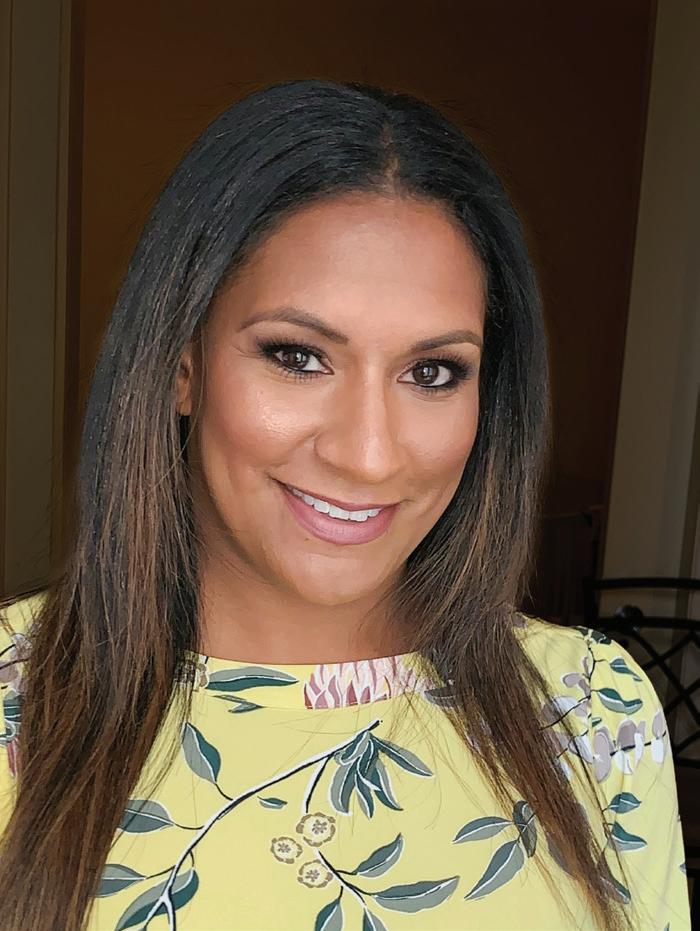
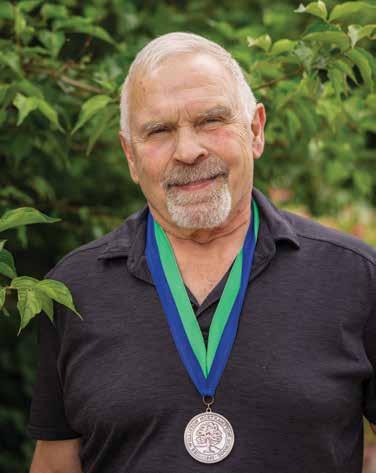
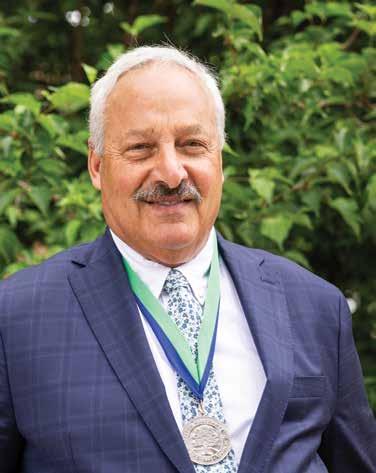
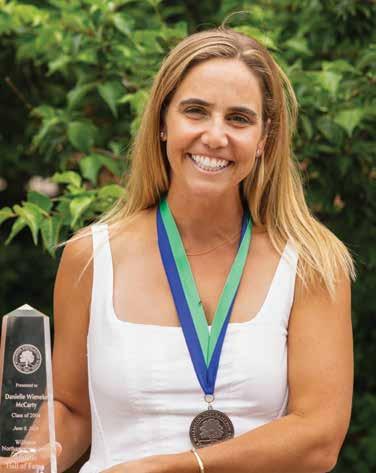

lected to the Western New England All-Division team, and chosen for the New England East-West All-Star Game. His exceptional performance earned him the title of high school All-American, a first for Williston. He also won the Denman Bowl as the outstanding senior male athlete. At the Massachusetts Maritime Academy, Palombo continued to excel in all three sports, captaining each team, earning multiple all-conference honors, and setting school records in lacrosse for goals in a season and career. He was named the school’s Athlete of the Year, had his lacrosse jersey retired, and was inducted into the Mass Maritime Athletic Hall of Fame.
Mark Conroy, a pivotal figure at Williston Northampton, has had a profound impact during his tenure as Athletic Director and football coach. Arriving in 2000, he led the football team to an 84-47 record over 16 seasons, including three NEPSAC Bowl appearances, and produced numerous college-bound athletes and 33 All-New England players. Conroy’s coaching extended beyond football, involving stints with thirds tennis, girls varsity basketball, boys varsity basketball, and boys thirds basketball, accumulating 39 coaching seasons in 24 years. However, his influence as Athletic Director was even more significant. Known for his emphasis on sportsmanship and respect, he introduced new sports programs, improved athletic facilities, and hired a full-time strength and conditioning coach, greatly benefiting student-athletes.
Under his leadership, about 30% of each graduating class pursued collegiate athletics. Conroy’s dedication to student-centered care and innovative thinking earned him and his wife, Monique, the Distinguished Service Award.
Sam Greeley, from Winnetka, Illinois, came to Williston in 1967 and quickly established himself as a standout athlete. As a three-way player in football, he excelled as a running back, defensive back, and punter/punt returner, serving as team captain, leading the team in scoring, and earning Boston Globe All-New England honorable mentions in 1967 and 1968. In the winter, Greeley shone in hockey, tying as the leading scorer in his senior year with 39 points in 14 games. In track and field, he showcased his speed and versatility by competing in multiple events and serving as team captain. Greeley’s exceptional performance in football, hockey, and track earned him the Denman Award for top senior athlete. He continued his athletic career at Harvard, starting as a defensive back on the freshman team.
To say that the 1984 boys tennis team had a special season would be an understatement. Led by legendary teacher/coach Jack “Doc” Gow and a strong group of returners, the team entered the season with high expectations, but it is safe to say that they exceeded them. The team of
seven included a small, gifted group of upper- and underclassmen led by returner Michael Marchand ’84 and postgraduate Bob Loeber ’84, who would be named the team’s MVP at the conclusion of the season. Other team members included Barry Wadsworth ’88, Paul Hart Smyth ’85, Anuwatt Nivatvongs ’85, Todd Klyver ’86, and Ajoy Chakrabarti ’86. The team won in every conceivable way that spring, including decisive wins over Worcester, Vermont, and Western Massachusetts power Longmeadow and four thrilling 5-4 match victories over Pomfret, Berkshire, Avon, and Mt. Hermon. The highlight of the season was a 7-2 drubbing of a historically strong Deerfield team. While recordkeeping gets spotty the further you go back in Williston athletic history, the records we do have indicate that the 1984 boys tennis team may very well be the only undefeated boys tennis team in the 115 years that tennis has been o ered at Williston. Without question, the 1984 boys tennis season was a very special season.
The girls lacrosse team entered the 2009 season with some pressure on them: The previous year, the Wildcats had gone undefeated. Fortunately, the 2009 team proved up to the challenge, putting together another unbeaten season and keeping the team at the very top of girls lacrosse teams in New England, winning a Class B Western New England title and a Central New England Tournament championship. Led by Head Coach Jen Fulcher, the 2009 Williston team
was a determined, hungry, and decisive group of players that finished the season with a perfect 11-0 record, extending the program win streak to a remarkable 26 games. The season included many memorable wins, including a come-from-behind overtime win over a previously undefeated Su eld team and a thrilling overtime win over Choate that was sent to an extra period on a last-second shot by freshman Bridget Instrum ’12. In the Central New England tournament, S.A. Fogleman ’10, Katie Pettengill ’09, and Katie Palasz ’09 were named to the all-tournament team, while Palasz and Fogelman were also named New England all-stars. Fogelman also was named an honorable mention AllAmerican. Palasz took home the Davis MVP Award for the season, while Sarah McCullagh was named Most Improved and Gillian Mann ’09 won the Kate Risley ’93 Sportsmanship Award. Palasz and Pettengill capped off stellar careers that spring with Pettengill finishing her career with 153 goals and 57 assists, while Palasz scored 154 goals for her career.
The team roster included Mika Black ’10, Anna Carando ’11, Laura (Bartus) Eldridge ’09, S.A. Fogleman ’10, Liz Gans ’09, Courtney (Aquadro) Goldsmith ’11, Jill Grant ’11, Abby Hatch ’11, Hannah (Oleksak) Haugh ’11, Bridget Instrum ’12, Amanda Lovell ’09, Gillian Mann ’09, Sarah McCullagh ’10, Julia Midland ’10, Katie Palasz ’09, Katie (Pettengill) Blizzard ’09, Karly (Simpson) Cullinane ’13, Jenna Spooner ’10, Stephanie (Kapinos) Tonissi ’09, and Meghann Treacy ’11.



In conjunction with his 20th Reunion, Ted Caine ’04 recreated a show of his late mother’s Williston portraits and reflected on her enduring vision
Ilike to paint people. I like especially to paint people that I can relate to, that are connected with my own life, people that I love.” So began the artist statement for Elizabeth Solley Caine’s exhibit, “The Many Faces of Williston,” which she created in 2003 when her son, Ted Caine ’04, was a junior. The show— which featured 26 evocative and deeply personal paintings of students and faculty—was rehung in June at Reunion, as a celebration of her life, following Solley Caine’s death from cancer in 2023.
“My mom always encouraged my creative side,” said Ted during his remarks at the show’s opening. “She supported everything I did, which brought her to Williston campus often. She designed outfits for my dance ensemble pieces, posters for theater productions, and the set for our sopho-
more year musical, Guys and Dolls.” In 2003, Solley Caine embarked on the portrait project, doing 60-minute sessions with each model and, in the process, learning about their lives. “I’m struck by how she was able to capture the feelings behind the model,” says Caine. “It wasn’t all happy—there is a duality at play in the pieces; vibrant youth full of energy and life, and deep, sometimes dark, inner thoughts, worries, and concerns.” Caine, who works as the Chief of Staff of a comprehensive youth services nonprofit in New York City, says he sees this duality often in his own work.
Seeing classmates Solley Caine painted posing next to their original portraits moved many who attended the show. “It was amazing how she captured a spark of each person’s spirit that you can still see today,” said Art Department Chair Natania Hume.

Caine ’04 stands next to the portrait his mother, Elizabeth Solley Caine, painted in 2003. Below, Caine and his father, Tom.


Solley Caine’s portraits of Alex Auriema ’03 (above), Gaya Hetiarachi ’04 (right), and Jennifer (Paulino) Mckinnie ’04 (above, right)
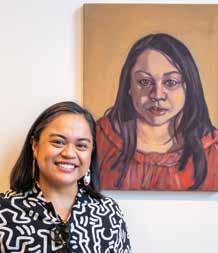

From young alumni college meetups and networking events to receptions, dinners, and holiday parties, alumni gathered near and far to reconnect and keep our sense of community strong. The following alumni events took place between April 2024 and June 2024. We’ve got so much planned for the year ahead, too; check williston.com/alumni/events for upcoming events, registration information, and lists of who’s coming to what.



APRIL 11:















From
Lynn Maziarz ’93, Jennifer (Pelli) Packard ’93, and Jon Packard ’93

(TENTATIVE SCHEDULE)

• DECEMBER
12/3: Western Mass. Holiday Celebration, Garden House at Look Park, Northampton
12/5: NYC Holiday Celebration, New York Yacht Club
12/10: Boston Holiday Celebration, Hampshire House
• FEBRUARY
2/12: Founders Day
2/22: Calling All ’Cats: On-Campus Theater/Arts Reception
• MARCH
3/9 Red Sox Spring Training Game and Picnic, Fort Myers, Fla.
• APRIL
Professional Networking Event, Boston, Mass.
Young Alumni Reception, NYC
Alumni Reception, Philadelphia, Pa.
Alumni Reception, Washington, D.C.
Alumni of Color Event, NYC
• MAY
Alumni Brunch, Los Angeles, Calif.
• JUNE
6/5–6/6: On-Campus Northampton School for Girls 100th Anniversary Celebration
6/6-6/8: Reunion, Celebrating the classes ending in 0s and 5s

Back for their fifth Reunion, close to 40 members of the class of 2019 returned to campus in June. With many of them staying overnight in Memorial Hall, the new brick terrace became a central hangout spot, harkening back to “chilling and grilling” days during senior year.

If you do not see your class year listed, then your class does not have an assigned class rep or any notes this issue. To send your news, see page 76, or contact Deleney Magoffin in the alumni office at dmagoffin@williston.com or 413529-3101.
1952
Classmates Sy Marchand, Henry Zachs, and Jack “Whitey” Galanek reunited back on campus this past June (see photo above). Sy attended Reunion weekend, and Henry and Jack were in attendance at the Elm Tree Luncheon.
The following members of the class of 1954 came back to campus to celebrate their 70th Reunion: Joel Katz, Sandra (Tigh) Peterson, Jerry Rosen
Alan Lazarus shares a photo (above, right) from the Yale campus and writes: “Fond memories…actually a very fond memory. Picture taken on the edge of freshman campus; the chairs in setup mode for a graduation. Calmer campus days.”
Jerry Rosen shares a photo of himself (opposite page, top left) and


Joel Katz from this past Reunion. He says: “It’s unfortunate that more classmates were not able to attend and reminisce with us and experience the beautiful upgrades that have taken place in the physical plant over the years. In addition to now being coed, it is not the same Williston we attended. We enjoyed the luncheon, the campus tour, and meeting some of the administrators, parents of former students, and other alumni.”
The following members of the class of 1959 came back to campus to celebrate their 65th Reunion (see class photo with some attendees, opposite page): Alan Case, Phil Fisher, Bill Haynor, Chip Palmer, Andy Solomon, Olney White, Sydney Williams
Andy Solomon writes: “Although there were less than a dozen of us there, we had a wonderful time catching up and reminiscing. The faces were familiar and, through the glasses of time, we saw each as we were. My son, Rex ’84, who was celebrating his 40th Reunion, and I had made a Great American Road Trip of the weekend and drove from Houston. It was lovely having special time with what became a 21-day, 5,000-mile adventure. As a wonder-
ful Father’s Day surprise, another son, Keith ’87, flew in from California. How wonderful it was to have my two boys with me.
We visited relatives, the Brattle Book Shop, Harvard Square, Wilson’s Diner, and many other places in all the New England states: Maine, New Hampshire, Vermont, Massachusetts, Connecticut, and Rhode Island; and then down the Eastern Seaboard, taking in the National Air and Space Museum at Washington Dulles International Airport—seeing on one day two B-52 and Blackbirds, unique opportunities. Together, we have seen now all battleships in the continental United States, also the dormant ocean liner SS United States, sadly standing at pier falling into scale in Philadelphia. We pushed southward through serious weather, finding shelter beneath overpasses.
We stopped at all the Buc-ee’s and Friendly’s we could find—wonderful culinary experiences—and indulged our off-diet fancies to be remembered forever.
To make things even more interesting, shortly after returning home, Category 1 Hurricane Beryl made a beeline directly to Houston and up on the 20th floor, the wind flew by at 100 mph and the sound coming from the fireplace roared like a freight train! We were lucky to have minimal rain damage and never lost power, though over 2 million did so and it took weeks before it was restored. After the hurricane, I contracted

COVID-19 and was banished to the bedroom and ordered to stay in bed and be waited on hand and foot by my wonderful wife of 61 years this upcoming August. Oddly, the last time I contracted COVID was during the Winter Olympics and I was forced to bed to watch it without interruption. Interesting how history repeats itself.
Although Tom Korson was not able to attend the Williston Reunion, he sent a picture from his 60th Harvard Reunion to keep memories of his classmates alive.
Adding to the pleasure of classmates coming together, Flip Stevens [Phil Stevens’ son] took time off from his own 65th Reunion at our nemesis, Deerfield, to join us. Flip Stevens and several of us at Reunion were students back in the day at the Williston Academy Junior School.
Bob Stilson passed away in July. Our class will miss him. He was one of us who was distinguished by always playing by all the rules.

Jim Aldrich gathered updates from his classmates. First he writes: “Myself and my wife, Linda, are very pleased we moved into El Castillo life-plan community in Santa Fe, New Mexico. Our location, only a block and a half from the Santa Fe Plaza, puts us within walking distance of everything from cultural events to a grocery store. I enjoyed leading three field trips last year for the El Castillo residents. The bus here holds 14 passengers, thus the need to run the same trip three times to accommodate all those who signed up for it. I prepared a guidebook for the trips titled Geology and Art Field Trip: Santa Fe to Ghost Ranch: O’Keeffe on the Rocks. The trip focused on the route’s geology with stops at key geologic locations and at places where Georgia O’Keeffe created some of her famous landscape oil paintings (pictured in the guidebook). During stops, I gave a brief overview of the landscape’s geology and then discussed techniques O’Keeffe used in her representation of the landscape. The guidebook has sections on the geology along the trip’s route, O’Keeffe’s life, and the local history of mining, Indigenous peoples, and Spanish occupation. I gave a presentation talk entitled “Mantle Plumes in Our National Parks and Monuments.” The residents have expressed a lot of interest and appreciation for


my field trips and talks, which has given me the impetus to develop other offerings for 2024. If any of you come to Santa Fe and would like a tour (they are free, of course), I’d be happy to provide one if my schedule permits.”
Jim Andrews writes: “I’ll see what I can put together for the Bulletin. Typing one-handed, coming off wrist surgery a couple of days ago, chronic arthritis, not a fall. I’ll write when I’m a bit more dexterous.”

Jim Aldrich ’60 (center) posing at Ghost Ranch with several field trip participants
Ed Bertozzi shares that he had several longtime friends and neighbors pass away in 2023, some of whom courageously fought debilitating illnesses until the end. He commented how the deaths of these people who were close to him has made him

more aware of the importance of spending the precious time we have left as wisely and productively as possible, giving serious thought to our life decisions and experiences and the knowledge we have gained and then passing it on to our children, grandchildren, and friends. He looks forward to having quiet time with each of them, discussing life’s ups and downs and how to make it better, especially in the long run.
Merritt Carlton chimes in from Málaga, Spain: “We were in the process of getting ready for our annual winter adventure in Spain; it is our favorite European country. We spend three months there and use it as a base for our travel adventures. This year: Sevilla, Córdoba, Barcelona, and, next week, Cádiz. Professor Thomas would still be disappointed in me. Still have a hell of a time speaking Spanish to communicate. Back in Maine, I see Carlton Winslow and Bud Woodworth often.”
Bob Cartelli continues to stay busy working and adding to the dealership
count! He’s a grandfather again with his youngest daughter adding grandson Miles to the Cartelli clan. Bob sends his best to all those remaining.
Tom Gordon said he and Jane were lucky to take their two-week trip to Israel in January before all the trouble began. He wrote: “It was a truly inspiring trip, but I think we might be getting a little too old to try many more as assiduous as this. We also toured the Canadian Maritimes for two weeks this summer. We plan to spend a couple of months in Florida this winter and hope to see Bob Varnum and Mary while there. The little aches and pains that accompany my age are with me always, but I consider myself blessed to still be basically quite healthy.”
Skip Gwiazda and Suzanne are happily retired and enjoying living at The Forum at Rancho San Antonio retirement community in Cupertino, California. The big 2023 event for Skip was the Gwiazda family gathering in July. The West Coast family—Skip, Suzanne, Josh, Jona-

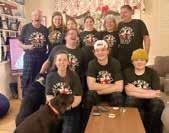
than, Maura, Orion (10), and Ruby (8)—flew to meet their East Coast relatives: Ron, Connie, Amy, Ethan, Jeremy, Libby, Serena (15), Juliet (8), Audrey (6), Thomas, and Rebecca (6) in West Roxbury and Brookline, Massachusetts (see photo). In October, they took a two-week trip to France with Skip’s brother, Ron, and his wife, Connie, going from Toulouse to Paris with stops at the prehistoric caves, Mont St. Michel, Normandy beaches, Giverny, and more. Suzanne kept busy during the year writing plays. Skip continued working on a book, tentatively titled White Supremacy From the Spanish to the Nazis and Beyond—driven by his longtime interest in why someone becomes a radical and why anyone else listens to them.
Phil Haskell and Rosine took a “bucket list trip/cruise” to New Zealand (which he really loved) and Australia in January. They were in Deerfield Beach, Florida, until May, with a break to Englewood Beach on Manasota Key, which he considers the “best place in all of Florida,” and then were in Newburyport, Massachusetts; Seabrook Beach, New Hampshire, and their cottage at Winnipesaukee for the summer. As Phil says: “Tough life, but someone’s got to do it.” Rosine did a Christmas trip to England with her kids and their families for Christmas and Phil did the same with his family at Kathy and son Steve’s house in Vermont (see photo). Phil had minor correc-
tive surgery in February and a full right knee replacement at the end of August that “worked out great after pre- and post-PT.” Phil says his family is great. Steve and Kathy’s daughter, Charlie, graduated from Clemson and is now enrolled in a doctoral program in pharmacology in Nashville, Tennessee. Grandson Sam is loving his sophomore year at High Point University. Granddaughter Tela is totally involved and enjoying her freshman year at University of Denver, and Sadie (a junior) and Zach (a freshman) are taking every advantage that Rice Memorial High School in Burlington, Vermont, has to offer and are into extreme/freestyle skiing and biking. Phil and Rosine left Florida again on January 2.
Bill Hastings said he’s glad 2023 is over. He didn’t say why he’s glad it’s over. If you see Bill, you might consider asking him about it.
Sam Hawkes says that as he ages he’s more and more surprised that he’s still here—and more and more transfixed by the miracle of life and the vastness of the universe. He commented: “I’ve given up bicycle riding and wonder why I ever thought that was so much fun. I spend less time in my violin shop and more time in my ‘sleepy’ chair; a moniker earned by my ability to go to sleep in it almost every time I sit in it.” Sam and Gale still keep bees, which is becoming more taxing for them, but now leave the gardening to a professional who “knows when to plant and prune.”
Lans Hays writes: “I have given up my New Yorker subscription. During my working years the magazine pile grew weekly until I hurriedly read the articles that seemed a must. Eventually I stopped reading the poetry… around the time I admitted I did not have the capacity to finish the New York Times Saturday crossword, either. Somewhere in middle age I stopped reading the short casuals and soon thereafter dance and recital reviews. Now in my 81st year, I am down to reading the cartoons and laughing when I get it. I still watch the news, even read print journalism, and follow politics the way a pilgrim flays his back hoping the pain will clear the mind. I have given up my television remote. Book print is getting smaller, and I find I need to tip my eyeglasses up more, but I still can read. My children call with problems raising their children. I try to come up with good advice. My smartphone has so many focus and silent means to set and reset that I generally do not hear it ring at all. Sometimes, like once every two months, a text catches up with me…if I look. My smartphone is smarter than I. I am supposed to be on a rocking chair on a porch, but I avoid rocking chairs because they are difficult to arise from. I need a steady foundation—like flat rocks. Soon, my legs will not hold me up. I expect I will become horizontal like the horizon, no longer care if my pants are rolled, become indifferent to politics and the cruelties of men, and watch the stars at night and ponder their godlike mysteries.”
Hall Healy shares: “All my remaining body parts are working; lost a couple along the way. It’s amazing that in the modern days of medical miracles we are able to survive without some of them, in large part through chemis-
try—as one friend has said, ’modern living through chemistry.’ Near the end of the year, I had a second encounter with COVID-19, though not a serious one. My wife, Anne, of 51 years, quarantined me to a few select rooms (not including the kitchen), and magically didn’t catch it herself. Other than that, it was a healthy year, marked by lots of swimming in the pool and in Lake Michigan when it was warm enough. (A couple of years ago, I bought a wetsuit and tried swimming in the lake on November 1, when the water was 60. The suit helped a lot, but at the ripe age of 80 at the time, I decided not to try that again!) The discipline of swimming several times a week really seems to help maintain good health in general and a more positive outlook on life, even though I’m usually the slowest guy in the pool! (Who’s trying to set any records?) Very stimulating for us are two book groups to which we belong, one in English, another in French. Little did I realize when taking French from Mr. Boardman as a teenager how rewarding it would be in my 80s to still be able to converse in another language. The book groups give us the opportunity to have engaging discussions with interesting people on novels as well as books about race relations, the environment, and other topics of the day. I read a bit about our world’s entanglements, including climate change, the divisions in this country, and our global conflicts. They are terribly disturbing, particularly when I realize that there’s not much I can do about them as one person. That’s when it’s helpful to talk with our three grandchildren, our daughter, and her husband, to gain a more hopeful perspective.”
Steve Herbits said he didn’t have
anything to say about 2023 but is devoted to two projects in 2024. One of the projects is a book he is authoring with someone else on federal criminal justice that’s a story of Department of Justice abuse. They have not circulated the prospectus to publishers yet, because Steve is having an independent lawyer review it to avoid problems with libel and slander. The other project involves a major effort on the 2024 election in North Carolina to see that the U.S. remains a democracy.
Richie Kagan informed me (your class representative) that the bocce trophy his team won was incorrectly reported in the Spring 2023 Bulletin. As written, the Class Notes say his team won the Wycliffe trophy. Richie pointed out that Wycliffe was the name of a neutral court for the league finals, not the name of the trophy. The trophy his team won was a Palm Beach County trophy. His Class Notes submittal ends with: “We are old men. Our minds tell us what to do and how to perform. Unfortunately, our bodies do not agree with our minds. Not much else to report.”
Tom LaSalle was thoughtful to let his class representative know he did not have anything to report. Thank you, Tom!
Chip Mead joined a group of 69 “Florida Citizens Alliance” volunteers early in the year to review 38 potential public school textbooks to determine if they include “woke” and “social justice” material. Only 10 of the books were judged to be consistent with the new constraints on subjects under Florida state law. He also reviewed an interactive “online” fundamentals of finance course that is now being used in over 5,000
public school systems nationwide. Chip’s wife, Reggie, continued her Moffitt Cancer Center volunteer work and joined the Sarasota Smith Club Board, where she has a monthly book club meeting. Chip and Reggie enjoyed visits from several friends during the year, some of whom they took to bars and restaurants, and did sightseeing and house hunting in Florida. Other trips took them to New Hampshire and Arlington Cemetery in Washington, D.C. On the trip north they attended their granddaughter Piper Mead’s graduation from Greens Farms Academy, and on the return trip they visited her as a freshman at Dickinson College in Carlisle, Pennsylvania. The “big event” for the year for Chip and Reggie was a gathering of the entire Mead family: Jon, Carla, cousin Vicki, Len, Amanda, and grandkids Piper, Cleo, and Max in Vegas. As a replacement for their 4-year-old beagle, Lana, that died from cancer, they adopted Missy, a smaller breed and an 8-year-old kennel beagle, from Tampa Bay Beagle Rescue. As they said: “Now for lots of training!”
Frank Merrick reported: “Susie and I still divide our time between Summit, New Jersey, and Wilmington, Vermont, but our granddaughters’ lives have changed drastically. The oldest, Francesca, graduated from NYU Law School and now works for Davis Polk, a large corporate law firm in New York City. The twins, Sammy and Kayla, entered high school in Butler, New Jersey. Samantha, the only girl running cross-country for the school, earned the sisters’ first varsity letter. Their younger sister, Natalie, entered middle school and is in her third year of playing soccer.
Nils Mikkelsen said: “During 2023,
I went to see my little sis in New York and family in Chile, as well. Other than that it has been uneventful. Looking to get some cataract surgery in 2024. Otherwise, I’m doing OK.”
David Milne has had the extremely unfortunate situation of his wife, Joyce, being very ill, but the family marked her 98th birthday on January 12, 2024, with a gathering filled with laughter and love. The good news is, in late January, she continued making a slow recovery, and David hopes to have her back home soon. If you’re in touch with David, please send him your best wishes. David said: “I continue to keep my mind active serving on a great many committees at Dartmouth Health. I have been a volunteer Patient Family Advisor for nearly 15 years. I meet with committees at the Dartmouth-Hitchcock Medical Center, the medical school, and the Dartmouth Cancer Center. In addition, I enjoy mentoring a Dartmouth College student each year. The individuals with whom I serve give me hope for the future wellbeing of our country.”
On December 31, 2023, Dick Powers wrote: “Good to hear a voice from the past. We are fine and fly out from St. Louis tomorrow at 5 a.m. to Hawaii. This is our 12th trip there and it’s kind of like going off to summer camp! We are fortunate.”
In reply to my request for a Class Notes write-up, Pete Savage, whom I (Jim Aldrich) also didn’t hear from last year, let me know he’s OK. He said: “Thank you for staying in touch. My wife, Ninky, and I are both doing well enjoying retirement. We travel as often as we can afford and are loving life in Duxbury, Massachusetts.” Writing back to Pete I mentioned that
I had enjoyed going to Duxbury as a young boy to visit friends.
Richard Stewart says he did substitute teaching for grades pre-K to nine and loved it. He found it to be the perfect job for balancing recreation with work. He continued to sing in the Winston-Salem Symphony Chorus, doing Beethoven in April; and he did church music (choir, bell choir, and occasional solos). Richard also spent time serving as a docent at the Reynolda House Museum of American Art in Winston-Salem, North Carolina.
Dave Torrey wrote: “Not much else to report other than I visited Easthampton in October [2023]. I walked around the campus and watched soccer practice at Galbraith Fields. I enjoyed the restaurants like Glendale Grill, Silver Spoon, etc. I am disappointed that our class didn’t have a Reunion in recent years to make up the one canceled by COVID.”
Bob Varnum wrote: “I will send you something during January. We, like you, are doing OK. Usual aches and pains. Nothing more.” Unfortunately, I (Jim Aldrich) didn’t receive anything else from Bob. I hope all is well with him.
Frank Williams said he didn’t have any activities to report. Many thanks, Frank, for the reply! It’s greatly appreciated! I wish I could get our reclusive classmates to at least acknowledge the messages I send to them.
Carlton Winslow commented that he and Kitty, who live on the midcoast of Maine, are not far from their son, daughter, and four grandchildren. They see Merritt Carlton from time to time and would welcome any


classmates who might be visiting the Rockland area.
Woody Woodward said he has ended his trips to Africa with 12 safaris, and shoots once a week on an English-style driven pheasant shoot. He explained the pheasant shoot, somewhat shortened by your class rep, this way: “You are driven with dogs and beaters so that they (generally) fly high coming at the guns (shooters) rather than going away and offer difficult shots. The firearms used are always break-action shotguns. We put out 2,000 pheasant a year (feeding two tons of cracked corn annually) and generally expect to harvest 850 birds, which are divided between the guns. Our club, inspired by a shoot on a local ranch owned by an Englishman who emigrated in the 1880s, was started by a group of rodeo cowboys, one of whom left me his membership in his will. Because we buy the birds, we are allowed greater bag limits and longer seasons. The ranch

that we conduct our shoot on is at the foot of the Bighorn Mountains in a steep canyon, from which mule and whitetail deer, moose, and at least one mountain lion have been seen escaping the drive over the years. I ran the hunt for 20 years, using my experience shooting driven when I was stationed in Germany and Belgium. We have a couple of days each year when we wear ties, as they do on the continent. Our 14 members have included ranchers, physicians, small business owners, and one Air Force officer (me).”
Bud Woodworth wrote: “I am still on the board of the Owls Head Transportation Museum, where I have been in charge of building a state-ofthe-art, humidity-controlled storage building and a restoration facility with dedicated woodworking shop, metalworking shop, and paint shop for the antique airplanes and cars. When the weather cooperated, we used our East Bay 38 for cruising all around Maine waters of Penobscot Bay and places east. I also decided on September 17, 2023, to marry Kat, and we went off on our boat for two weeks as a honeymoon. We are now back in Stuart, Florida, and enjoying the warm weather and getting out in my boat with my brothers, Warren
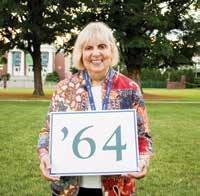

and Don, and their wives. Life is good and we’re having a lot of fun. I still have excellent health and hope to have it for many years to come. If anyone is in the Stuart area, look me up and we’ll get together and have something to eat or drink or a run in the boat.”
Paul Fein writes: “My fifth tennis book, Game Changers: How the Greatest Players, Matches, and Controversies Transformed Tennis, was released August 1 by Coaches Choice. It’s been a labor of love, and I hope readers love it. I fondly remember playing on the varsity tennis team under coach Archibald “Heppy” Hepworth with Tom Zavorski, Dick Sheldon, George Master, Art Kaiser, Dick Shepardson ’63, and Bob Rowe ’64— all players with better strokes than mine. We had a lot of fun, and my enthusiasm for tennis grew over the decades. I hope my command of English also increased and would have made my English teachers, especially Charles Rouse, proud. My early reporting experience on the Press Club helped ignite my passion for writing. Journalism is a noble profession and more important than ever today.”
The following members of the class of 1964 came back to campus to celebrate their 60th Reunion (see class photo with some attendees, above): Mike Brewer, Stephen Greene, Hammy Hamilton, Jack Heflin, TJ (Francese) Shaum, Jon Sibley, Jeff Taylor
Jon Sibley submitted his Class Note during Reunion this past summer. Jon writes: “Jim Sibley ’67 and I have a technical manufacturing company. My wife, Merry (Hall) Sibley ’65, and I have arrived at our 50th wedding anniversary. My interest in pipe organs continues. An alumni-donated pipe organ was installed in the old chapel near The Schoolhouse. I am installing a 1935 Wurlitzer Theater organ at home. Much has changed on the campus since I graduated. The Stevens Chapel was being built during my senior year.”
Jeff Taylor was present at Reunion this past summer, and while on campus he shared a memory of his time at Williston. Jeff writes: “I remember learning to raise and lower the flag to half-staff the day JFK was assassinated.”
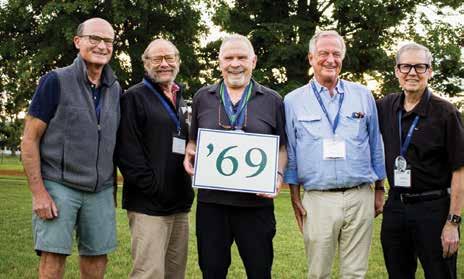
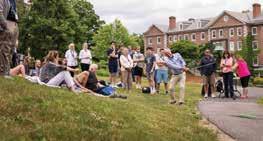

As always, communications and exchanges of pleasantries and other thoughts from the Guys of ’65 poured in with little encouragement from class agent Teak Kelley, who is spending his summer in the Lakes Region of New Hampshire. One of our most consistent contributors, Jeff Bastable, noted that entries from the Class of ’65 “took up half of the Class Notes section of the last edition of the Bulletin.” And Jeff hoped that our record would continue. As if on cue, Chris Zook wished all of the Guys of ’65 a Happy 4th of July from the Pacific Northwest, and we heard from classmates Steve Holcomb, Bill Hough, Jerry Flynn, Ned Lynch, Jack Robinson, and Alex Chen, who all emailed in with wishes of good weather and good health for all this summer.
In these uncertain and sometimes contentious political times, the “Guys” agreed to leave the exchange of those views to others, at another time, and in a different forum. This sentiment was mirrored by our class President, Rich “Savage” Reingold, and a few other level-headed classmates.

Charles Ross ’71 (right) and his wife, Rita, at the wedding of their son Charles Jr. to Tyler Hastie. Also pictured are his son Reid Ross and his wife Charisma and their three daughters, Feliz (8), Zoe (6), and Lizzie (2).

Another faithful contributor of news for the Bulletin, Charlie Hayes, who presently lives in Maryland, passed through our campus in early summer and offered that the school “looked lovely, but [that he] felt like a relic from another era.” He guessed that all the Guys of ’65 are relics!
David Stevens retired from his active law practice when COVID shut down the courts, eliminating his trial work. David is now enjoying retirement in California. Another retired, successful lawyer, Dave Beebe, took a golf trip to Alabama in the winter and, back home in Western Massachusetts, notes that his club, The Orchards in South Hadley, is in great shape—he invited Teak, a former member, for a round of golf. Hopefully, we can reprise our winning foursome at our 60th Reunion: Dave, Roger Walaszek, Skip Jarocki, and Teak
Harvey Kaltsas updated that his shipwreck search is progressing. He writes: “I expect to bring up more artifacts soon and hopefully some treasure. When I do, Williston will get a healthy chunk toward its scholarship efforts. Our alma mater deserves full support from all of us.”
Teak reminded all the Guys of ’65 of our 60th Reunion in June 2025, and encouraged all to stay in touch and plan ahead!
The following members of the class of 1969 came back to campus to celebrate their 55th reunion (see class photo with some attendees, above): Gary Baumer, Peter Clark, Mark deShong, Sam Greeley, Brigotti Mair, and Lansing Pugh.
1970
55TH REUNION IN 2025
1971
Charles Ross retired from the NFL Players Association in December. He plans to spend more time with the family and reflect on his next chapter. He sent in a family photo from his son Charles Jr.’s June 2023 wedding to Tyler Hastie (see above).
1972
Steve August had a wonderful overnight stay with Chuck Tauck and his wife, Fran, at their home in Ithaca, New York, on July 29–30. Chuck
gave Steve a VIP tour of Sheldrake Winery and Vineyards, which he has owned and operated for 30 years. It was great catching up on all things Williston!
Nils Berg writes: “Greetings from Riyadh. No news to report from the sandbox except that my Williston brother, Abdulrahman Alagil, class of 2018, was in Cipriani for dinner a few nights in July with his incredibly brilliant father!”
Judith (Miller) Conlin writes: “I went to camp! The very same music camp that I have been going to for nearly 30 years. We gather in Craigville Village on Cape Cod on a Thursday afternoon, and by Sunday we perform a concert of a dozen or more choral selections in their 150-year-old open-air tabernacle. I have made many dear friends there over the years and learned lessons about music and life that I am deeply grateful for. I am also grateful that there were no jellyfish in the water this year!”
Thomas Davis has retired after 40 years of teaching architectural and urban design, first at Syracuse University for 10 years, followed by 30

From left: Michael Wills ’72, Charlie Moore ’73, and Barry Searle ’73 performing in the Time Stretchers at Reunion 2024
years at the University of Tennessee (Knoxville). Thomas writes: “My wife of 45 years, Marleen Davis, and I, with my childhood and lifelong friend Steve August, attended the day of celebration last October for our beloved Coach, Rick Francis. Our two sons, with one granddaughter each, live in Washington, D.C., and Nashville, Tennessee. It was great to see all the positive physical improvements throughout the campus, as well as in Easthampton itself.”
Michael Wills shares: “I had the pleasure of reconnecting with Yorke Lawson after 50 years, courtesy of Jim Gaffey, Yorke’s old Williston roommate. Yorke and I caught up over the phone. A real treat came a couple of months later when ‘Gaff’ took a long trip south and spent a couple of days with Yorke along the way. The night Jim got into Lenoir, North Carolina, the two of them called me, and we had a great conversation! I also traveled to Harvard, Massachusetts, in early July to celebrate Charlie Moore ’73’s 70th birthday! It was a great gathering of family, friends, and musicians and a marvelous weekend! Charlie and I had just performed with Barry Searle ’73 and his band, the Time Stretchers, at Reunion 2024.
Betty (Chase) Hyde gathered up-

Jeff DeCaro ’73 and Todd Stall ’73
dates from her classmates. First, she writes: “The summer has gone by quickly. I attended Reunion in June. It was great to see old friends from the class of 1974. The week following Reunion I went to Newport, Rhode Island, to volunteer at the U.S. Senior Open golf tournament. Chrissy LoBello, Vinny LoBello’s sister, was my partner in crime. We stayed with Debbie (Carpenter) Jerome. It was great exploring her neighborhood. I am looking forward to another winter skiing at Smugglers’ Notch Ski Area. I am headed to France for a week skiing in the Alps. This is my 70th birthday present to myself. It never gets old, and I’m hoping I can ski into my 80s.”
Alicia (Divoll) Socker shares to class rep, Betty: “Hello Betty! Funny thing, I was just thinking about you. Hope you and the family are all well. People magazine should do an article and cover shoot of you and your travels, skiing triumphs, etc.! My news is that my Jesse is finally recovering well after his almost deadly accident last November. We live in the path of Hurricane Ian and, as a builder, Jesse hit the rebuilding biz (he had been building new homes and also became a realtor). Upon inspecting our roof, he fell partially through. He drove himself to the emergency room because there was little bleeding but the main concern was his knee was possibly sprained or worse. They sent
him home and told him to stay off his feet for a few days. They did not clean the wounds. The next morning, he was screaming to call an ambulance. His leg was black from ankle to thigh and oozing blood. They were going to airlift him to Sarasota burn unit but could drive faster. It’s an hourplus from our house. A flesh-eating disease was the cause! The emergency room in Englewood screwed up. Nineteen surgeries, three months in the hospital, and three months of at-home nursing care, and he is finally able to walk again. I am happy to report Jesse is back to ‘Jesse the Builder!’ We almost lost him. I was told by two doctors that a half-hour more and he’d be gone.”
Dave “Grizzy” Griswold writes: “Hey Betty, thanks for keeping on top of it. It was nice to visit with everyone in our Zoom. I’m enjoying my community as there’s always something going on. I’m trying to adjust to my solo life. I traveled to Seattle, Washington, and Aspen, Colorado, this summer to spend time with family. I’ve been working on my golf game again and thinking about taking up pickleball, which is a big deal here. I’m headed for my annual trip to Maine in a few weeks; lobsters beware! It’s cooler than Texas in August and September. I will be spending time with Jack [Tatelman] in Marblehead and will see Rig, Brad, and maybe even Henry along the
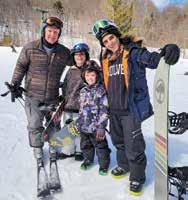
Three generations of the DeCaro Family at Pico Mountain—Jeff DeCaro ’73 with son Dru DeCaro and grandsons Westly and Landon
way. Hope you all are having a great summer. I’m hopefully going to see my son in Mexico City this fall. All the best.”
Missy (Schy) Retsky writes: “Not the most exciting news, but I went to Tyler, Texas, for the eclipse, which was amazing. I then left to spend my 68th birthday in Italy in May. I spent the first week in Tuscany, where a girlfriend of mine from ninth grade runs a small tour company called Steps in Tuscany, after retiring from being a flight attendant for Delta for 42 years. It was great. She does four tours a year with a maximum of eight people. We stayed in a 400-year-old farmhouse. Then I went off for two weeks to Venice, Rome, Florence, Pompeii, and Positano. I got the travel bug and am leaving for three weeks in Scotland in early August and going back to Texas. Something about turning 68 that told me it’s time to travel while you can. I highly recommend it. Who knows how long we will be mobile.”
Jack Tatelman writes: “Thoroughly enjoying these days of leisure in my summer residence of Marblehead, Massachusetts. Between hours on the golf course and/or on the water, my wife, Debbie, and I are blessed to have our two grandchildren in close proximity. Their curiosity and innocence touches us on a daily basis. We are overwhelmed by their


hearts and conversation. Despite my efforts parenting, both my children turned out to be solid citizens maturing in their 30s. Jonathan runs a successful nonprofit mental health clinic and community center in Los Angeles, and my daughter, Jenn’s, newest project is a fly-fishing camp in Essex, Massachusetts. Life continues to provide me with great health and wonderful experiences. For that I count my blessings.”
Jeff DeCaro shares: “I spent a long weekend over Easter with Todd Stall

and his wife, Carol, at their place in Quechee, Vermont, and got in two days of skiing at Pico with my son and two oldest grandsons. I have the pictures to prove it!”
The following members of the class of 1974 came back to campus to celebrate their 50th reunion (see class photo with some attendees, above):
Carl Alford , Joe Conroy , Jane (Douty) Davis, Sarah (Boardman) Dermody, Jay Donovan, Thaddeus Dziemian, Karl Eichstaedt, Julie (Andrew) Emerson, Cheryl (Riley) Ewing, Heather Harts’horn, David Herrick, Conrad Johnson, Skip Lemanski, Thom MacDonnell, Penny (Dods) Molyneux, Matthew Padgett, Marc Palombo, Randy Saex, Tim Wallace
Cheryl (Riley) Ewing and Jane (Douty) Davis enjoyed reconnecting at Reunion 2024.

Dana Richdale sends an update on behalf of her class: “The sad news to report is the passing of Gil Dillard A thoughtful individual with a clear desire to contribute his energies and intellect into making the world a better place for all of us. Empathy goes out to his family and the many that he touched with his kindness and compassion. With each passing of a classmate, it makes one ponder their own mortality. Live each day with meaning and steely determination. I would be remiss too if I were not to mention the passing of Robert St. George, another stalwart of the school lost to the passing of time. He was what we would all define as a gentleman who led by example. If you go to the WNS website and access the In Memoriam page, you will see a well-articulated insight, as written by Rick Noland, relating, on a personal level, the meaningful

and lasting impact that Robert St. George had on Rick during his time at WNS. More remarkably, do an internet search, and you will see that Rick is an accomplished musician, along with his sister.
If you are eagle-eyed, you caught an image of Tom Downey in the last Bulletin publication. He was hanging with ’75 grads. Not sure how that gathering came about, but it was enjoyable to see the image. Tom, looking fit!
Another internet search yielded an update on Michael Delande. I have not heard from Michael for years, but I do recollect his abilities playing soccer, and that ability translated into his being a varsity soccer coach St. John’s Prep School for a number of years in Danvers, Massachusetts, back in the ’80s. Having spent many years traveling with our son to many competitive soccer matches, I came to appreciate the game later in life! I would be curious to hear his take on the current status of U.S. Soccer as well as MLS.”


The following members of the class of 1979 came back to campus to celebrate their 45th Reunion (see class photo with some attendees, above): Paula (Brusco) Banach, Charlie Carroll, Andrew Chase, Penny Corl-Carroll, Dyan deNapoli, Tom Enselek, Jon Hall, Maggie Hodges, Mary (Mullin) Jones, Sean Kardon, Sara (McAlister) LeTellier, Mary Logan, Owen Mael, Frank O’Brien, Cynthia (Brooks) Peyman, Sarah (Hopkins) Samore, Whitney Foard Small, Andrea (Ades) Woolner.
Suzanne Snyder writes: “Calling all Williston alumni! Do you live near one of our Sail Beyond Cancer chapters in Burlington, Vermont; Salem, Massachusetts; Annapolis, Maryland (D.C./Baltimore area); or our upcoming location in Newport, Rhode Island? I would love to connect with you! Come over to say hi

at our booth at either of these two shows: Newport International Boat Show September 12–15 or the Annapolis Boat Show October 10-14.
Do you know anyone being challenged by cancer? Nominate them for a sail! While you are at it, help make these sailing excursions happen with financial support—and YES, I am looking for YOU to help volunteer and make it all happen!
Together, with our WILLY SPIRIT, we ARE making a difference to cancer patients and their loved ones, One Sail at a Time!
Sail Beyond Cancer is a nonprofit that provides free, three-hour, private sails for cancer patients, their caregivers, and loved ones. We create opportunities for those being challenged by cancer to rebuild courage and make lasting memories. Anyone in treatment for any type of cancer, regardless of their age, income level, ethnic background, or other life circumstances, is eligible to come sailing with us. www.sailbeyondcancer. org.”
The following members of the class of 1984 came back to campus to celebrate their 40th Reunion (see class photo with some attendees, above):
Jen Bennett, Amy Brown, Kimberly (McGee) Cochran, Barrack Evans, Tim Farnham, Craig Ferri, Amy Hotchkiss, Lori (Antoniak) January, Michael Kriz, Lisa Lake, Bob Loeber, David Lucier, Michael Marchand, Bryant McBride, Rodney Moore , David Quinn , Lisa Rawlins, Tamsin Smith, Sally Smith Nicoli, Rex Solomon, Rob Squire, Jim Tobin, Cathy (Bardagy) Winchild
Elizabeth Corsini writes: “Sorry to have missed you all at Reunion! I live in Englewood, New Jersey. My fourth child is heading off to college and my husband and I will be empty nesters. After 20 years as an executive leader in a nonprofit organization, I left to start a consulting firm. The Collaborative for Organizational Change is dedicated to promoting equity
and justice in the workplace. I keep in touch with Jodes, Heather, and Birdie. I am so happy to have reconnected with Bryant McBride and DG and would love to see any one of my former classmates at any time!”
Bob Loeber writes: “ Mickey Marchand and I (I still don’t know if I should be using I or me there… remember I was a PG) were fortunate to be members of the 1984 undefeated tennis team which just got inducted into the Williston Athletic Hall of Fame (the fact it was our Reunion was a nice little bonus). We join fellow ’84’ers Billy Okun and Bryant McBride, who have already been inducted. I think the biggest reason this happened was the Willy administration finally gave in to Mickey’s persistence and ability to remember every detail of that season, because I’m not sure the school has any documentation that we actually went undefeated. When I got the unexpected email from the school I was sitting on the couch with my dad, which is something I will always remember (along with showing my wife and kids the medal, because they still don’t believe I actually played tennis). The best part of this whole experience was Doc Gow, who was our coach. He is such a legit person, and his coaching and leadership were the main reason for our success. He hasn’t changed a bit. He showed up with a bag of Williston tennis hats
th REUNION

See list of class of ’84 Reunion attendees, opposite page

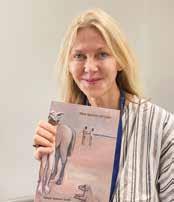
(they were Nike, by the way, so Doc stepped up on that one) and gave them to the two of us along with our teammates Todd Klyver ’86 and Paul Smythe ’85. The next couple of hours we spent with Doc were priceless, and all four of us came away a better person after being with him—which has always been a talent of his. After that it was off to the Reunion, which was awesome, although I have to say I am still fascinated with the fact that Doc Gow actually lived next door to the legendary Brett Stoddard. I never knew that, and when Brett told Doc it got old back in the ’80s having to tell Doc to quiet things down every weekend, it was just another reminder why we were so fortunate to meet the people we did while we

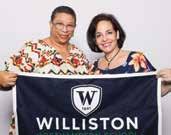

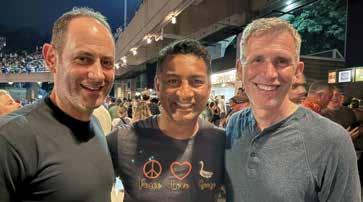
were at Williston!”
Michael Marchand shares: “Prior to our Williston Athletic Hall of Fame post-event photo, I felt it was important to reiterate to Doc how important his coaching, guidance, and leadership were to the team during that 1984 season. Bob also noted that it was great that our team’s athletic exploits finally elevated Doc’s Williston career to Hall of Fame status as opposed to the years of dedication and countless lives he impacted through his unwavering commitment as a teacher, counselor, and mentor. We all broke up laughing over that.”
Tamsin Smith shares: “My latest collection of poems, New Species of
Color, is out. My band WUNDERCAT is playing a series of shows in Northern California. Other than that, I’m enjoying the sunshine!”
Catherine (Bardagy) Winchild shares: “Seeing everyone at Reunion was the highlight of my summer. I fear that might make me sound like a loser (living for your high school years...all that), but it’s true! And I never laugh as hard as I do when I’m around my Williston classmates. Highlights from Reunion were: sleeping in Ford Hall with classmates, eating breakfast together in the dining hall (where they now have coarse salt, good coffee, and ready-to-order omelettes!), staying up late in the Ford common room,

learning that Bob Loeber played varsity tennis (what the what?!), a post-Reunion reservoir hike (that took the sting off leaving campus), and laughing so much, no matter where we found ourselves. But it wasn’t all fun and games. Wait until you experience how easy it is to get to the dining hall when you’re sleeping in Ford. You’ll resent every time your nose hairs froze leaving a girls’ dorm. Oh! And students no longer have to scale that chain-link fence to get to Galbraith Field. When we were kids, you feared scaling that fence every day, and you liked it! But in all seriousness, thank you to my classmates for all the laughs and making my summer. To those of you who could not attend, you were truly missed, and we look forward to seeing you at the 50th.”
1985
40TH REUNION IN 2025
1988
Brett Katzner, Rick Mason, and Jai Chanda reconnected at a Goose concert in New Haven, Connecticut, in June (see photo, above).

’89 Reunion



The following members of the class of 1989 came back to campus to celebrate their 35th Reunion (see class photo with some attendees, above): Michael Asinas, Lisa Baker, Chad Beyerle, Becka Blake, G.P. Gro -
macki, Paul Haaland, Deb Kagan, Melanie (Belanger) Koumentakos, Jeff Lovelace, Sarah Marchand, Shannon Martin, J.D. O’Brien, Taran Petricca, Damon Robbins, Earlon Seeley, Marcella (Yearwood) Tennant, Samantha (Healy) Vardaman, Patrick Woomer
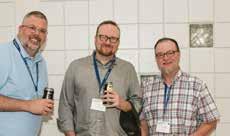
Lisa Baker, who currently works as an English teacher at Milton Academy, recently wrote an article for the National Association of Independent Schools entitled “Why We Need to Expect More,” which explores childadult relationships in both family and educational environments and
how teachers relate to students in a postpandemic world.


Paul Haaland shares: “My wife, Betty, and I enjoyed attending my Reunion this year. It was great reconnecting with my classmates. I’m still working in the nonprofit association field in the Washington, D.C., area. Both our sons graduated from Williston and are now in college. We look forward to seeing everyone at the next Reunion in 2029!”
35TH REUNION IN 2025
The following members of the class of 1994 came back to campus to celebrate their 30th Reunion (see class
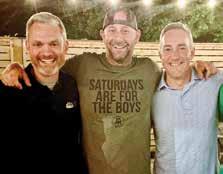
th REUNION

See list of class of ’99 Reunion attendees below
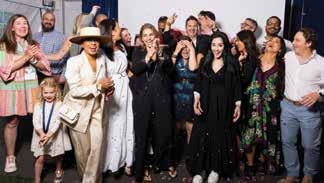


From left: Laurie Cormier and Alison
photo with some attendees, above):
Carl Augsberger, Jason Charpentier, Monet (McCorvey) Gaines, Mike Houle, Ryan Koller, Jamie LaFleur, Brett LaPierre, Aaron Lucas, Jeremy Mullen, Emily Till.
1995
30TH REUNION IN 2025
TJ Leenders writes: “I had a great
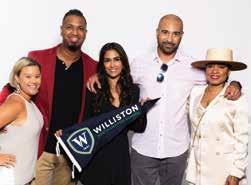

night catching up with Ryan Callahan and Luke Suchecki last weekend just outside of Boston. We shared a few drinks and lots of great memories!”
The following members of the class of 1999 came back to campus to celebrate their 25th Reunion (see class photo with some attendees, above): Rabiya Akhtar, Jeff Amanti, Fred Aquino, Christy (Eaton) Callahan, Alison Carberry Gottlieb, Alyssa (Condon) Corry , Kim Espina , Corie Fogg, Mark Foresi, Erica Frost Esquivel, Kendall JohnsonSmith, Gabe Kantor, Nar (Dong)

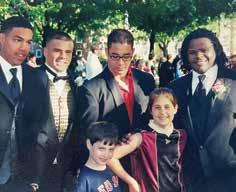
Lee, Yumi (Nakagawa) Lim, Jason Magnus, Andrea (Nicoli) Mascaro, Colin Matthias, Matt Naylor, Jenna (Borowski) Pelech, Izzy Pichardo, John Polizzi, Marilyn Truitt Sanders, Katie Viola-Downey
2000
25TH REUNION IN 2025
Katherine (Boucher) Wesmiller, joined by her parents, Anna Marie and Laurence Boucher, visited with Williston alumni staff in Saratoga, California, this past spring to hear about upcoming alumni events in California and her 25th class Reunion next June.

Then and now! Middle photo, from left: Kevin Conroy ’12, Monique Conroy P’10, ’12, Zamian Charles ’02, Eden Charles, Mark Conroy P’10, ’12, and Kristina Conroy ’10, at Reunion 2024. At left: Pierce Freelon ’02, Eric McGuirl ’01, Habib Rachidi ’02, Zamian Charles ’02, Kristina Conroy ’10, and Kevin Conroy ’12 at prom 2001
The Advancement Office recently visited alumni in Tennessee. It was wonderful seeing Alison (Wool) Hirt at McCallie School in Chattanooga, where she and her husband both work and their son is a seventh grade student (photo, bottom left).
Former faculty member Mark Conroy shared the then-and-now photos, above, and wrote: “I thought this was a pretty cool picture of my kids with Zamian Charles from Friday night and 23 years ago at prom (spring






2001). Zamian pretty much lived at our home. Others pictured are Pierce Freelon, Eric McGuirl ’01, and Habib Rachidi. Zamian and Pierce played the lead roles in Guys and Dolls their senior year when Pierce was captaining basketball and Zamian was the New England heavyweight wrestling champion and an All-American. My recollection is that the production played two consecutive weeks, Thursday through Saturday, and was SRO every performance.”
Laura (Wilson) Shaw shares: “Tiffany (Cutting) Madru and I were both selected for BusinessWest’s 40 Under 40, an honor that recognizes young professionals for their career achievements and their service to
the community in Western Massachusetts. The evening was spectacular, but celebrating with a few more Williston alums made it even better! Chelsey (Cutting) Wold ’07, Joe Wold ’06, Ian Vukovich ’01, and Hannah Rechtschaffen ’01 were also in attendance. It was so nice to catch up with them all.”
Joe Cavallaro recently hosted a Willy cookout (see photo, above left)
Several members of the class of 2003 returned to campus recently for Reunion weekend. While it was not the group’s “official” year, this group of ’03s (pictured at left) got together to honor the Conroys and to

continue the Reunion energy after an impressive 20th Reunion attendance last year. Mike Wieneke and Lela Griffin also met up with the group on Saturday for various Reunion events.
The following members of the class of 2004 came back to campus to celebrate their 20th Reunion (see class photo with some attendees, above): Paige Brinkley, Ted Caine, Daniel Clionsky, Devon Collins, Maggie D’Amour, Lou Daigle-Costello, Rob Eckstut, CeAnna Ellner, Emily Follansbee, Peter Forester, Ashley Gilbert Winfrey, Wes Hardy, Alexa Hudson, Maretchel (Quiminales) Joyner, Alex Judd, Josh Kaufman, Rene LaPlante, Jennifer (Paulino)



Mckinnie, Ellie Molyneux, Areeje (Akhtar) Oriol, Katie (Coffey) Pasciucco, Rose Peck, Adam Shepard, Tomi Uyehara, Shannon (McWilliams) von Thaden, Danielle Wieneke McCarty, Cate Wright.
Class of ’04—Act III reunites and poses with their eponymous CD debut.
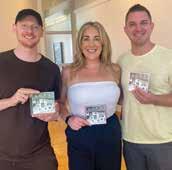

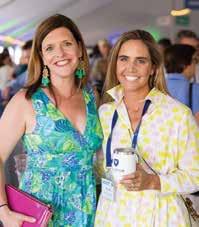

Alex Teece shares: “I made it back to the East Coast this summer for a Boston and Vermont trip with my two little ones—baby number three (our first girl) is on the way!”
Morgan (Stall) Ahearn welcomed baby number three in April of 2024.
(See photo, at right.)
Katie (McAuley) Poff shares, “I ran into Lilah (Brown) Desabrais ’05 this spring when our kids were on the same baseball team! Western Vermont is truly the Western Massachusetts of the (slightly farther) North!”



Emily (Laird) Dresser gave birth to a beautiful baby girl, Eleanor Laird Dresser, on June 24.
Logan Kirkpatrick recently held an art show entitled “Emotions in Reflections” at the Big Red Frame’s Elusie Galley in Easthampton August 3–31.
Michael MacDonald writes: “I wanted to share our newest addition to the MacDonald family, Reilly Ann MacDonald, born March 2, 2024, in Fort Lauderdale, Florida.”

th REUNION


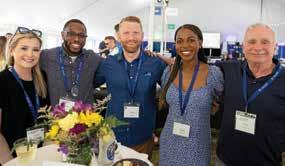


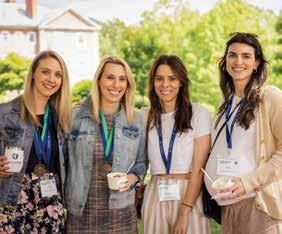






list of class of ’14
The following members of the class of 2009 came back to campus to celebrate their 15th Reunion (see class photo with some attendees, above): Esther Ayuk, Laura (Bartus) Eldridge, Lauren Katz, Dakota Ledford, Gill Mann, Josh Parad, Taylor Scyocurka, Mikayla Strycharz, Dana (Collins) Tennyson, Stephanie (Kapinos) Tonissi, Andre White
Rafael Cortina Jr. shares his new bundle of joy, Remy Carlo Vega Cortina, born October 23, 2023.
15TH REUNION IN 2025
Kristyna (Bronner) Frantz welcomed twins Eleanor and Wesley in June with husband, Zach, and big brother, Bennett.
Dan Gould was married on June 9,

2023. His father, a current employee of Williston, was in attendance along with some fellow alums.
Joyce Li recently relocated to Hong Kong to spearhead a new private equity fund focused on Southeast Asia. Her journey has led her to reconnect with old friends and forge new connections. During her stay, she embarked on a memorable reunion exercise. Joyce visited Jesse Cheng ’11 in Guangzhou, where his company, Shopmicas.com, has blossomed into an international clothing brand, catering to customers worldwide. Joyce caught up with KP Park ’06 at DST Global, a pioneering PE fund with a strong Asian investment focus. Their discussions centered around the ever-evolving landscape of investment opportunities in the region. Over a delightful meal, Joyce met Zoe Lai, who now manages investor relations at JP Morgan. Their conversation touched upon the intricacies of financial markets and global business dynamics. Next on Joyce’s agenda is a meetup with Dickson

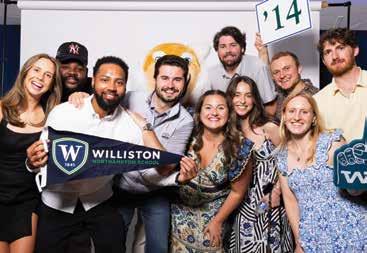
Wong ’11, who leads the Kingstar international trading firm. They hope to share experiences that promise exciting prospects for collaboration and business synergies.
As the reunions continue, Hong Kong and the greater Bay Area of China alumni eagerly anticipate more connections, memories, and potential ventures!
The following members of the class of 2014 came back to campus to celebrate their 10th Reunion (see class photo with some attendees, above): Marquis Francois, Hannah Gagnon, Brendan Hellweg, Alex Kozikowski, Meredith Peppes, Taylor Potasky, Zach Pyser, Ledell Robinson, Persis TicknorSwanson, Caleb Wint.
Livvy Milne shares: “After three long years and many clinical hours, I graduated with a master’s in clinical social work with a certificate in trauma
practice from Simmons University in Boston. I plan on continuing to



5th REUNION


work with youth in the Boston area and studying for my independent license.”
Catie (Laraway) Santaniello ’14 welcomed her son, Crizanzo Scott Santaniello, on July 23, 2024. Crizanzo weighed 6 pounds, 11 ounces at birth.
2015 10TH REUNION IN 2025

See list of class of ’19 Reunion attendees below
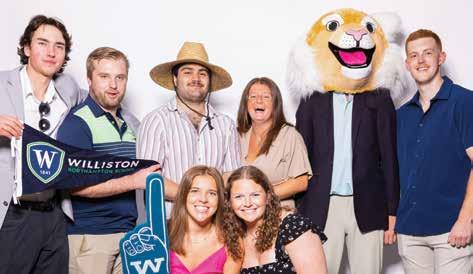
Sonia Berghoff ran into former music teacher Joshua Harper. He shares a photo and writes: “A privilege to see former high school students out living their best adult lives. Even more amazing when they were a music major in college and now teaching music themselves! So good to see you, Sonia Berghoff, and proud of all you are doing! Great reminiscing about all the good times at the Williston Northampton School!”

Maisy Glick was married in Washington, D.C. this past June and had several Williston alums in attendance at the ceremony.
Destiny Nwafor and GB Osuntogun ’18 were back on campus in July to talk with the College Advising team from Williston—as well as a few other local prep schools—about their new start-up, Pathfinder. Pathfinder uses AI-powered quizzes and other tools to give people more clarity about their skills, personality, and aptitudes, and suggests future college and career paths.
From left: Stephen Goldsmith ’15, Martha McCullagh P’10, ’13, and Michael Dereus ’16 at the retirement reception for Mark and Monique Conroy in June


The following members of the class of 2019 came back to campus to celebrate their 5th Reunion (see class photo with some attendees, above): Sally Alrutz, Magnolia Armstrong, Nick Barber, James Belleavoine, Alex Berg, Kyler Breland, Aidan Burke, Rachel Burke, Claudia Capone, Chelsea Clark, Sophie Cowperthwait, Erin Daley, Chris Denham, Caroline DiFiore, Ryan Dwyer, Emma Gentile, Reilly Gluz, Ella Goodman, Dora Gordon, Katie Han, Claire Harrison, Robby Hill, Kate Holmes, Insoo Kang, Walter Kissane, Ari Koumentakos, Tom Lawry, Aidan McCreary, Nhi Kylee Nguyen, Jack Purcell, Kate Quimby, Hunter Sarro, Sabrina Shao, Molly Solan, Wyatt Wegrzyn, Emily Whipple, James White.



During time spent in Western Massachusetts this summer, former cross-country teammates Nat Markey and Nick Hill ’17 caught up while logging some miles in the Tuesday night Northampton 5k race—and back on the Williston course with DJ Poulin ’19.
Tucker Motyka shares a photo of the last show of his band, Dreamscape’s, northeast summer tour at New City Brewery in Easthampton at the end of May (with guest vocals by Julia Borden ’22). They had previously played shows in Philadelphia, New Jersey, and New York City.


Destiny Nwafor ’17 and GB Osuntogun ’18, after meeting on campus with Alex TancrellFontaine (left) and Emily McDowell (right)

This listing contains the names of alumni whose deaths were reported to the school between March 27, 2024, and August 26, 2024, although their passing may have occurred outside those dates.
William F. Armstrong of Shrewsbury, Massachusetts, died May 19, 2023. He is survived by his son, William; his daughters, Abby and Halley; four grandchildren; and one great-grandchild.
1946
Charles D. Showalter of Pinehurst, North Carolina, died March 17, 2024. He is survived by his daughters, Susan and Kim; his sons, Stephen, John, and Paul; and six grandchildren.
1950
Carl L. Lo Conte of Medford, Massachusetts, died October 28, 2023. He is survived by his wife, Bridget; his sons, Carl and Christopher; his daughter, Carla; four grandchildren; and two great-grandchildren.
1951
Sally Poole Farnham-Jaferian of Pasadena, California, died November 21, 2021.
1954
Joel Schiavone of New Haven, Connecticut, died April 22, 2024. He is survived by his partner, Emily; his children, Allyx ’88, Josie, Bryan, and Maxim; and grandchildren Penn ’20, Josie, and Ripley.
1955
Judith (Mason) Dittrich of Worcester, Pennsylvania, died May 25, 2024. She is survived by her daughters, Jackie, Tracy, and Gretchen; her sons, Gunnar, Ralph, and Rob; and ten grandchildren.
1957
Barbara (Watt) Bradley of St. Paul, Minnesota, died March 29, 2023. She is survived by her husband, Peter; her daughters, Laura and Carrie; her sister Carrie; and three grandchildren.
Rodney M. Jaros of Danbury, Connecticut, died June 28, 2024. He is survived by his daughter, Emily; his sons, Mark and Matthew; his sister, Melanie; and four grandchildren.
1959
Robert M. Stilson of Fairfield, Connecticut, died July 17, 2024. He is survived by his wife, Susanne; his daughter, Laura; his son, David; and three grandchildren.
Paul E. Thorpe of Northampton, Massachusetts, died November 18, 2019. He is survived by his wife, Teresa; his daughters, Sara and Olivia; and five grandchildren.
1960
Henry S. Hacker of Boston, Massachusetts, died June 6, 2024. He is survived by his sons, Michael and Matthew; his daughter, Katrina; and four grandchildren.
1961
Newell S. Doty of Hendersonville, North Carolina, died March 30, 2024. He is survived by his wife, Ronnie; and his daughters, Kristin, Katie, and Betsy.
1968
Douglas S. Fuller of Sarasota, Florida, died April 8, 2024. He is survived by his wife, Pamela; his step-daughter, Angela; his sister, Susan; his brother, Rob; and four grandchildren.
1969
Brooke A. Chambers of Manhasset, New York, died March 27, 2024. He is survived by his wife, Mary.
Charles R. Donnellan of Valencia, California, died May 5, 2024. He is survived by his sisters, Mary Ricker (Donnellan) Leao-Martin ’65 and Virginia (Donnellan) Eberhard ’67.
Karen Papageorge of Englewood, Florida, died April 17, 2020.
1971
Michael L. Kinsler of North Chittenden, Vermont, died March 22, 2024. He is survived by his wife, Martha; his children, Erron, Micah, Annah, and Jared; his sister, SueAnne; and nine grandchildren.
1976
Gilbert B. Dillard III of Springfield, Massachusetts, died July 7, 2024. He is survived by his daughters, Gennea and Tianna; his mother, Opal; his sisters, Bonita and Dorothy; and his brothers, Goren ’80 and Gravin.
1988
James K. Manfield of Worcester, Massachusetts, died June 12, 2024. He is survived by his son, Javin; his father, James; and his sister, Christine.
2006
Chloë Constance Kriebel Metcalf of Northampton, Massachusetts, died February 29, 2024. She is survived by her mother, Sarah; her father, George; and her brother, Simon ’09.
2015
Dorothy Annika Smith of Berkeley, California, died July 8, 2024. She is survived by her partner, Ian; her mother, MegAnn; her father, Steven; and her brother, Hanson.
Your classmates are up to cool things! Find out more by flipping to the pages below.
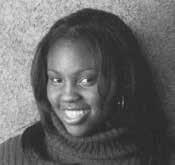



See page 50

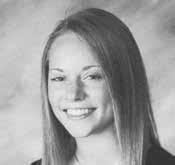

See page 52
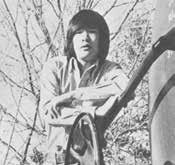
See page 42
See page 43

See page 50
See page 56

See page 66
See page 66

See page 68

See page 48
Change Service Requested


Parents: If this issue is addressed to a child who no longer maintains a permanent address at your home, please notify the Alumni Office of the correct new mailing address by contacting us at alumni@williston.com or 413–529-3300. Thank you.




